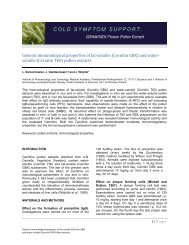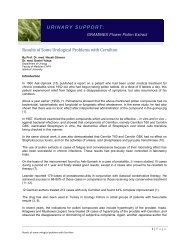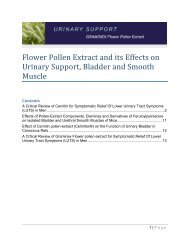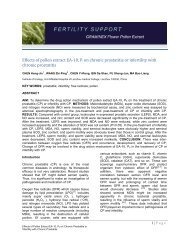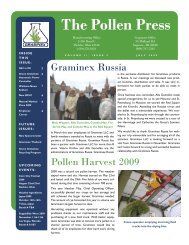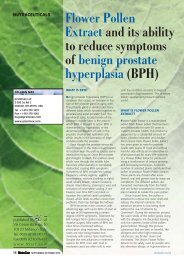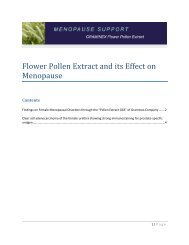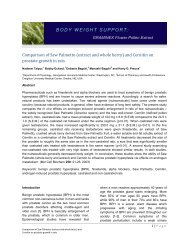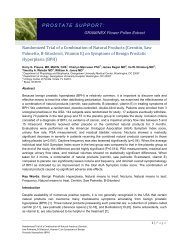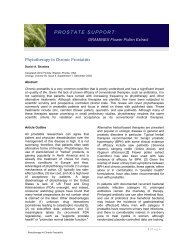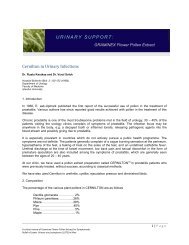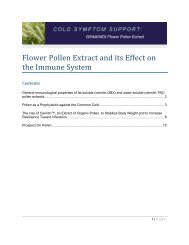Flower Pollen Extract and its Effect on the Liver - Graminex
Flower Pollen Extract and its Effect on the Liver - Graminex
Flower Pollen Extract and its Effect on the Liver - Graminex
Create successful ePaper yourself
Turn your PDF publications into a flip-book with our unique Google optimized e-Paper software.
<str<strong>on</strong>g>Flower</str<strong>on</strong>g> <str<strong>on</strong>g>Pollen</str<strong>on</strong>g> <str<strong>on</strong>g>Extract</str<strong>on</strong>g> <str<strong>on</strong>g>and</str<strong>on</strong>g> <str<strong>on</strong>g>its</str<strong>on</strong>g> <str<strong>on</strong>g>Effect</str<strong>on</strong>g> <strong>on</strong><strong>the</strong> <strong>Liver</strong>C<strong>on</strong>tentsHepatoprotective effect of flower pollen lipid extract in paracetamol-induced hepatotoxicity in mice.......... 2The <str<strong>on</strong>g>Effect</str<strong>on</strong>g> of <strong>the</strong> <str<strong>on</strong>g>Pollen</str<strong>on</strong>g> <str<strong>on</strong>g>Extract</str<strong>on</strong>g>s Quercitin <str<strong>on</strong>g>and</str<strong>on</strong>g> Cernitin <strong>on</strong> <strong>the</strong> <strong>Liver</strong>, Lungs, <str<strong>on</strong>g>and</str<strong>on</strong>g> Stomach of RatsIntoxicated with Amm<strong>on</strong>ium Fluoride........................................................................................................... 3Experimental evaluati<strong>on</strong> of <strong>the</strong> effect of pollen extract <strong>on</strong> <strong>the</strong> course of paracetamol pois<strong>on</strong>ing ................ 7<str<strong>on</strong>g>Effect</str<strong>on</strong>g> of pollen extract (Cernitin ) <strong>on</strong> <strong>the</strong> course of pois<strong>on</strong>ing with organic solvents ............................... 8<str<strong>on</strong>g>Effect</str<strong>on</strong>g> of <str<strong>on</strong>g>Pollen</str<strong>on</strong>g> <str<strong>on</strong>g>Extract</str<strong>on</strong>g>s (Cernitin preparati<strong>on</strong>) <strong>on</strong> Selected Biochemical Parameters of <strong>Liver</strong> in <strong>the</strong>Course of Chr<strong>on</strong>ic Amm<strong>on</strong>ium Fluoride Pois<strong>on</strong>ing in Rats.......................................................................... 9The Protective <str<strong>on</strong>g>Effect</str<strong>on</strong>g> of <str<strong>on</strong>g>Pollen</str<strong>on</strong>g> <str<strong>on</strong>g>Extract</str<strong>on</strong>g>s Against Allyl Alcohol Damage of <strong>the</strong> <strong>Liver</strong>.................................. 10The <str<strong>on</strong>g>Effect</str<strong>on</strong>g> of <str<strong>on</strong>g>Pollen</str<strong>on</strong>g> <strong>on</strong> <strong>the</strong> Changes in <strong>the</strong> <strong>Liver</strong> of Laboratory Rats Evoked by Ethi<strong>on</strong>ine, Carb<strong>on</strong>Tetrachloride, Allyl Alcohol <str<strong>on</strong>g>and</str<strong>on</strong>g> Galactosamine ........................................................................................ 13The <str<strong>on</strong>g>Effect</str<strong>on</strong>g> of Cernitins <strong>on</strong> Galactosamine-Induced Hepatic Injury in Rat.................................................. 141 | P age
Hepatoprotective effect of flower pollen lipid extract in paracetamol-inducedhepatotoxicity in miceCzarnecki R, Librowski T, Polanski M.Katedra Farmakodynamiki Collegium Medicum UJ.Hepatoprotective effects of <strong>the</strong> lipid flower pollen extract (LEPK) in paracetamol intoxicati<strong>on</strong> in mice were shown.Normalisati<strong>on</strong> of A1AT <str<strong>on</strong>g>and</str<strong>on</strong>g> LDH--biochemical indicators of necrotic changes in <strong>the</strong> hepatic cells, <str<strong>on</strong>g>and</str<strong>on</strong>g> high protecti<strong>on</strong>ultra structural cell organelle such as mitoch<strong>on</strong>dri<strong>on</strong> substantially testifies to <strong>the</strong> hepatoprotective effect ofinvestigated lipid flower pollen extract <strong>on</strong> <strong>the</strong> hepatic cells.PMID: 10481382 [PubMed - indexed for MEDLINE]Folia Med Cracov. 1997;38(3-4):53-61.Hepatoprotective <str<strong>on</strong>g>Effect</str<strong>on</strong>g> of <str<strong>on</strong>g>Flower</str<strong>on</strong>g> <str<strong>on</strong>g>Pollen</str<strong>on</strong>g> Lipid <str<strong>on</strong>g>Extract</str<strong>on</strong>g> inParacetamol-Induced Hepatotocity in Mice2 | P age
The <str<strong>on</strong>g>Effect</str<strong>on</strong>g> of <strong>the</strong> <str<strong>on</strong>g>Pollen</str<strong>on</strong>g> <str<strong>on</strong>g>Extract</str<strong>on</strong>g>s Quercitin <str<strong>on</strong>g>and</str<strong>on</strong>g> Cernitin <strong>on</strong> <strong>the</strong> <strong>Liver</strong>, Lungs, <str<strong>on</strong>g>and</str<strong>on</strong>g>Stomach of Rats Intoxicated with Amm<strong>on</strong>ium FluorideHUMICZEWSKA M., HERMACH U., PUT A. 1994. The effect of <strong>the</strong> pollen extracts Quercitin <str<strong>on</strong>g>and</str<strong>on</strong>g> Cernitin o <strong>the</strong> liver,lungs, <str<strong>on</strong>g>and</str<strong>on</strong>g> stomach of rats intoxicati<strong>on</strong> with amm<strong>on</strong>ium fluoride. Folia biol. (Krakow) 42: 157-166.Quercitin <str<strong>on</strong>g>and</str<strong>on</strong>g> Cernitin are not in <strong>the</strong>mselves toxic to rats. When administered at <strong>the</strong> time of intoxicati<strong>on</strong>of <strong>the</strong> animals with amm<strong>on</strong>ium fluoride, <strong>the</strong>y reduced <strong>the</strong> noxious effects of <strong>the</strong> toxic agent I <strong>the</strong> liver <str<strong>on</strong>g>and</str<strong>on</strong>g> lungs. It issuggested that Quercitin <str<strong>on</strong>g>and</str<strong>on</strong>g> Cernitin might play a protective role during prol<strong>on</strong>ged exposure to amm<strong>on</strong>ium fluoride.Nei<strong>the</strong>r amm<strong>on</strong>ium fluoride nor Quercitin or Cernitin seem to exert any effect o <strong>the</strong> stomach.Key words: pollen extracts, Quercitin, Cernitin, liver, lungs, stomach, amm<strong>on</strong>ium fluoride.Miroslawa HUMICZEWSKE, Urszula HERMACH, Department of Biology, Pomeranian Medical Academy,Powstancow Wielkopolskich 72, 70-111 Szczecin, Pol<str<strong>on</strong>g>and</str<strong>on</strong>g>.Anna PUT, Department of Pharmacology <str<strong>on</strong>g>and</str<strong>on</strong>g> Toxicology, Pomeranian Medical Academy, PowstancowWielkopolskich 72, 70-111 Szczecin, Pol<str<strong>on</strong>g>and</str<strong>on</strong>g>.Fluoride compounds are <strong>on</strong>e of <strong>the</strong> most potent ecotoxins (MARIER 1972; GROTH 1975; MARKIEWICZ 1981).Several publicati<strong>on</strong>s discuss <strong>the</strong> toxic acti<strong>on</strong> of fluorine <str<strong>on</strong>g>and</str<strong>on</strong>g> <strong>the</strong> problem of reducing <str<strong>on</strong>g>its</str<strong>on</strong>g> emissi<strong>on</strong> (GUMINSKA 1981;MARKIEWICZ 198; DOMINICZAK et al. 1982; HUMICZEWSKA et al. 1989). In <strong>the</strong> search for cheap, easily availablepharmacological means, devoid of side effects, which would reduce <strong>the</strong> harmful changes occurring with prol<strong>on</strong>gedintoxicati<strong>on</strong> with fluorides, attenti<strong>on</strong> was paid to pollen extracts. The latter, which have been employed for years inphyto<strong>the</strong>rapy (c.f. OZAROWSKI 1982), were found to be very useful in various diseases of <strong>the</strong> kidneys <str<strong>on</strong>g>and</str<strong>on</strong>g> liver,playing a role also in detoxicati<strong>on</strong> processes (SCHWARTZ et al. 1982; KULAWIAK 1986). New, previously notdescribed, characteristics of pollen were revealed in investigati<strong>on</strong>s carried out in <strong>the</strong> Department of Pharmacology<str<strong>on</strong>g>and</str<strong>on</strong>g> Toxicology of <strong>the</strong> Pomeranian Medical Academy in Szczecin (KULAWIAK 1986; CEGLECKA 1991, 1991a;MYSLIWIEC 1992). However, those studies do not cover all <strong>the</strong> possibilities of exploiting pollen extracts. Fur<strong>the</strong>rinvestigati<strong>on</strong>s are <strong>the</strong>refore needed to establish <strong>the</strong>ir pharmacological characteristics <str<strong>on</strong>g>and</str<strong>on</strong>g>, possibly, o<strong>the</strong>r appliances.The aim of <strong>the</strong> present study was to investigate <strong>the</strong> histological <str<strong>on</strong>g>and</str<strong>on</strong>g> histochemical changes occurring in <strong>the</strong> lungs,liver, <str<strong>on</strong>g>and</str<strong>on</strong>g> stomach of rats exposed to amm<strong>on</strong>ium fluoride (NH4F), <str<strong>on</strong>g>and</str<strong>on</strong>g> to assess <strong>the</strong> possible beneficial effect <strong>on</strong> suchchanges of two pollen extracts, Quercitin <str<strong>on</strong>g>and</str<strong>on</strong>g> Cernitin, known as detoxicating agents.Materials <str<strong>on</strong>g>and</str<strong>on</strong>g> MethodsAnimalsThe investigati<strong>on</strong>s were carried out <strong>on</strong> 160 inbred,male Wistar rats, weighing approximately 300g each.Throughout <strong>the</strong> experiment <strong>the</strong> animals were fed ast<str<strong>on</strong>g>and</str<strong>on</strong>g>ard granulated chow <str<strong>on</strong>g>and</str<strong>on</strong>g> received water adlibitum.Expositi<strong>on</strong> to amm<strong>on</strong>ium fluoride (NH4F)The animals were placed in a toxicological chamber inwhich <strong>the</strong> parameters of humanity <str<strong>on</strong>g>and</str<strong>on</strong>g> temperaturewere adapted each time to those prevailing in <strong>the</strong>animal room. The air-flow through <strong>the</strong> chamber was10m3/h. Amm<strong>on</strong>ium fluoride was intrlduced asaerosol at a c<strong>on</strong>centrati<strong>on</strong> of 2mg/m3 of air, <str<strong>on</strong>g>and</str<strong>on</strong>g>c<strong>on</strong>trolled c<strong>on</strong>stantly by means of an i<strong>on</strong>o-selectivefluoride electrode. The above c<strong>on</strong>centrati<strong>on</strong>corresp<strong>on</strong>ds to <strong>the</strong> so-called Highest PermissibleC<strong>on</strong>centrati<strong>on</strong> established for men exposed to fluoridecompound at 0,0016mg/m3 of air (Decree of <strong>the</strong>Polish Council of Minister, September 30, 1980).In <strong>the</strong> present investigati<strong>on</strong> <strong>the</strong> animals were exposedto amm<strong>on</strong>ium fluoride for 6 h daily, 5 days a week.<str<strong>on</strong>g>Pollen</str<strong>on</strong>g> extractsAs pollen extracts Quercitin <str<strong>on</strong>g>and</str<strong>on</strong>g> Cernitin wereapplied. Quercitin (syn<strong>the</strong>sized in <strong>the</strong> Department ofInorganic Chemistry of <strong>the</strong> Rzeszow Branch of <strong>the</strong>Krakow Technical University) is a mixture of natriumThe <str<strong>on</strong>g>Effect</str<strong>on</strong>g> of <strong>the</strong> <str<strong>on</strong>g>Pollen</str<strong>on</strong>g> <str<strong>on</strong>g>Extract</str<strong>on</strong>g>s Quecertin <str<strong>on</strong>g>and</str<strong>on</strong>g> Cernitin <strong>on</strong> <strong>the</strong><strong>Liver</strong>, Lungs, <str<strong>on</strong>g>and</str<strong>on</strong>g> Stomach of Rats intoxicated with Amm<strong>on</strong>ium Fluoride3 | P age
salts of quercitin 8.5 disulph<strong>on</strong>ic acid i.e of Na2QDSAin which NaQSA-5’ <str<strong>on</strong>g>and</str<strong>on</strong>g> NaQSA-8 appear at <strong>the</strong> ratio1:1 (unpublished data).Cernitin (AB Cernelle, Veqeholm, Sweden) appears intwo forms, as a fracti<strong>on</strong> soluble in water (CernitinT60), <str<strong>on</strong>g>and</str<strong>on</strong>g> as a fracti<strong>on</strong> soluble in lipids (CernitinGBX). Cernitin T60 c<strong>on</strong>tains from 60 to 92% ofaminoacids, <str<strong>on</strong>g>and</str<strong>on</strong>g> Cernitin GBX from 10 to 16% ofphytosterols (NIELSON et al.1987, SEPPANEN1989). In medicine mixtures of <strong>the</strong> two fracti<strong>on</strong>s areused (NIELSON et al. 1987).On days when <strong>the</strong> rats were exposed to amm<strong>on</strong>iumfluoride <strong>the</strong> appropriate groups also receivedQuercitin <str<strong>on</strong>g>and</str<strong>on</strong>g> Cernitin preparati<strong>on</strong>s, previously addedto <strong>the</strong>ir chow. The doses applied ate given below.Grouping of animalsThe animals were divided into two series, eachcomprising 8 groups of 10 rats.Those of series I (Groups 2-8) were exposed toamm<strong>on</strong>ium fluoride <str<strong>on</strong>g>and</str<strong>on</strong>g>/or given pollen-extracts for 3m<strong>on</strong>ths, while those of Series II (Groups 10-16)underwent <strong>the</strong> same experimental procedure but for 6m<strong>on</strong>ths.Group 1 was <strong>the</strong> c<strong>on</strong>trol for Series I, <str<strong>on</strong>g>and</str<strong>on</strong>g> Group 9 forSeries II. The two c<strong>on</strong>trol groups were nei<strong>the</strong>rexposed to NH$F, nor given pollen extracts <str<strong>on</strong>g>and</str<strong>on</strong>g>remained throughout <strong>the</strong> experiment in <strong>the</strong> animalroom.Groups 2 <str<strong>on</strong>g>and</str<strong>on</strong>g> 10 received Quercitin at dose I, i.e.30mg/kg b.w./day.Groups 3 <str<strong>on</strong>g>and</str<strong>on</strong>g> 11 received Quercitin at dose II, i.e.20mg/kg b.w./day.Groups 4 <str<strong>on</strong>g>and</str<strong>on</strong>g> 12 received Cernitin T60 (100 mg/kgb.w./day <str<strong>on</strong>g>and</str<strong>on</strong>g> simultaneously, Cernitin GBX (200mg/kgb.w./day).Groups 5 <str<strong>on</strong>g>and</str<strong>on</strong>g> 13 were exposed to NH4F <strong>on</strong>ly.Groups 6 <str<strong>on</strong>g>and</str<strong>on</strong>g> 14 were exposed to NH4F <str<strong>on</strong>g>and</str<strong>on</strong>g> receivedQuercitin at dose I (as <strong>the</strong> animals of Groups 2 <str<strong>on</strong>g>and</str<strong>on</strong>g>10, respectively).Groups 7 <str<strong>on</strong>g>and</str<strong>on</strong>g> 15 were exposed to NH4F <str<strong>on</strong>g>and</str<strong>on</strong>g> receivedQuercitin at dose II (as <strong>the</strong> animals of Groups 3 <str<strong>on</strong>g>and</str<strong>on</strong>g>11, respectively).Groups 8 <str<strong>on</strong>g>and</str<strong>on</strong>g> 16 were exposed to NH4F <str<strong>on</strong>g>and</str<strong>on</strong>g> receivedCernitin (as <strong>the</strong> animals of Groups 4 <str<strong>on</strong>g>and</str<strong>on</strong>g> 12,respectively).After c<strong>on</strong>clusi<strong>on</strong> of <strong>the</strong> experiments (Series I, i.e.Groups 2-8, <str<strong>on</strong>g>and</str<strong>on</strong>g> C<strong>on</strong>trol Group 1 after 3 m<strong>on</strong>ths), <str<strong>on</strong>g>and</str<strong>on</strong>g>Series II, i.e. Groups 10-16, <str<strong>on</strong>g>and</str<strong>on</strong>g> c<strong>on</strong>trol Group 9 after6 m<strong>on</strong>ths <strong>the</strong> animals were killed by decapitati<strong>on</strong>.Histology <str<strong>on</strong>g>and</str<strong>on</strong>g> histochemistryAfter killing <strong>the</strong> animals, <strong>the</strong> lungs, liver, <str<strong>on</strong>g>and</str<strong>on</strong>g> stomachwere dissected out. Tissue specimens intended forhistological examinati<strong>on</strong> were fixed in Bouin’s fluid,embedded in paraffin, secti<strong>on</strong>ed at 8nm, <str<strong>on</strong>g>and</str<strong>on</strong>g> stainedwith Mayer’s haematoxylin <str<strong>on</strong>g>and</str<strong>on</strong>g> aqueous eosin.For histochemical analysis <strong>the</strong> tissues wereimmediately frozen, <str<strong>on</strong>g>and</str<strong>on</strong>g> alter cut <strong>on</strong> a cryostat into10µm secti<strong>on</strong>s. Hisochemical reacti<strong>on</strong>s performed <strong>on</strong>this (unfixed) material included (1) succinicdehydrogenase (SDH) using sodium succinate assubstrate, according to Nichlas (PEARSE 1968), (2)acid phosphatase (AcP), <str<strong>on</strong>g>and</str<strong>on</strong>g> (3) alkalinephosphatase (AIP), using sodium-glicerophosphateas substrate according to Gomori, (PEARSE 1972).Following incubati<strong>on</strong> at 37° C (SDH for 30min AcP<str<strong>on</strong>g>and</str<strong>on</strong>g> AIP for 60min), <strong>the</strong> secti<strong>on</strong>s were embedded inglycero-gel. In order to c<strong>on</strong>firm <strong>the</strong> specificity of <strong>the</strong>particular enzymatic 5 reacti<strong>on</strong>s, c<strong>on</strong>trol reacti<strong>on</strong>swithout <strong>the</strong> substrates were simultaneously run.ResultsHistological observati<strong>on</strong>sHaematoxylin <str<strong>on</strong>g>and</str<strong>on</strong>g> eosin (HE) stained secti<strong>on</strong>s of <strong>the</strong>liver, lung, <str<strong>on</strong>g>and</str<strong>on</strong>g> stomach of c<strong>on</strong>trol animals (Groups 1&9) showed that <strong>the</strong> morphological picture of all <strong>the</strong>investigati<strong>on</strong>s organs was normal (Figs 1&5).L i v e r. In <strong>the</strong> liver of experimental animals exposedto amm<strong>on</strong>ium fluoride for 3 m<strong>on</strong>ths (Group 5) <strong>the</strong> livercells appeared brighter, this being caused byexcessive accumulati<strong>on</strong> of glycogen. The bloodvessels were extended, <str<strong>on</strong>g>and</str<strong>on</strong>g> in places fibrosis couldbe seen (Fig. 2).After 6 m<strong>on</strong>ths exposure to NH4F (Group 13), apartfrom <strong>the</strong> changes described above, <strong>the</strong> laminarstructure of lobules was obliterated, particularly at<strong>the</strong>ir peripheral parts. <strong>Liver</strong> cells seemed to bediffused, <str<strong>on</strong>g>and</str<strong>on</strong>g> no cleat borders between <strong>the</strong>m wereseen. The c<strong>on</strong>nective tissue str<str<strong>on</strong>g>and</str<strong>on</strong>g>s were moreextensive (Fig. 3).In <strong>the</strong> animals of groups 2, 3, <str<strong>on</strong>g>and</str<strong>on</strong>g> 4, which for 3m<strong>on</strong>ths received pollen-extracts <strong>on</strong>ly, no differencesin comparis<strong>on</strong> with c<strong>on</strong>trol Groups 1 <str<strong>on</strong>g>and</str<strong>on</strong>g> 9 weredetected. Similarly, no changes were found in <strong>the</strong>liver of animals given <strong>on</strong>ly pollen extracts for 6m<strong>on</strong>ths (Groups 10, 11& 12).The <str<strong>on</strong>g>Effect</str<strong>on</strong>g> of <strong>the</strong> <str<strong>on</strong>g>Pollen</str<strong>on</strong>g> <str<strong>on</strong>g>Extract</str<strong>on</strong>g>s Quecertin <str<strong>on</strong>g>and</str<strong>on</strong>g> Cernitin <strong>on</strong> <strong>the</strong><strong>Liver</strong>, Lungs, <str<strong>on</strong>g>and</str<strong>on</strong>g> Stomach of Rats intoxicated with Amm<strong>on</strong>ium Fluoride2 | P age
Rats exposed for 3 m<strong>on</strong>ths to amm<strong>on</strong>ium fluoride, butreceiving simultaneously Quercitin at dose I or II(Groups 6&7), of Cernitin (Group *) also did nor revealany differences., compared with c<strong>on</strong>trols.The same was true for animals of Groups 15 <str<strong>on</strong>g>and</str<strong>on</strong>g> 16(intoxicated for 6 m<strong>on</strong>ths, but simultaneously givenQuercitin at dose II or Cernitin). However, in <strong>the</strong> ratsof Group 14 (exposed to NH4F for 6 m<strong>on</strong>ths, <str<strong>on</strong>g>and</str<strong>on</strong>g>given Quercitin at dose I), some parts of <strong>the</strong> livershowed obliterati<strong>on</strong> of <strong>the</strong> interlobular blood vessels(Fig. 4).L u n g s. The results of histological observati<strong>on</strong> of<strong>the</strong> lungs ate summarized in Table 1.No pathomorphological changes were visible ei<strong>the</strong>r inc<strong>on</strong>trol Groups 1 <str<strong>on</strong>g>and</str<strong>on</strong>g> 9, or in rats which receivedpollen extracts <strong>on</strong>ly (i.e. Groups 2, 3, 4, 10, 11 & 12).Fig. 1. <strong>Liver</strong> of a c<strong>on</strong>trol rat (Group 9); identicalpictures were observed in c<strong>on</strong>trol Group 1. Hex 140.Fig.2. <strong>Liver</strong> of a rat exposed for 3 m<strong>on</strong>ths toamm<strong>on</strong>ium fluoride (Group 5). Note <strong>the</strong> brightening ofliver cells, <strong>the</strong> extensi<strong>on</strong> of blood vessels, <str<strong>on</strong>g>and</str<strong>on</strong>g> signsof fibrosis Hex 150. Fig.3. <strong>Liver</strong> of a rat exposed for 6m<strong>on</strong>ths to amm<strong>on</strong>ium fluoride( Group13). Note <strong>the</strong>extensi<strong>on</strong> of c<strong>on</strong>nective tissue str<str<strong>on</strong>g>and</str<strong>on</strong>g>s Hex 150. Fig,4, <strong>Liver</strong> of a rat exposed for 6 m<strong>on</strong>ths to amm<strong>on</strong>iumfluoride, but simultaneously receiving Quercitin atdose I (5mg/kg/day), (Group 14). Note someextensi<strong>on</strong> of capillaries, <str<strong>on</strong>g>and</str<strong>on</strong>g>, in at places, obliterati<strong>on</strong>of <strong>the</strong> laminar structure HE x 150. Fig.5. Lung ofc<strong>on</strong>trol rat (Group 9); identical pictures were observedin c<strong>on</strong>trol Group 1. HE x 150. Fig.6. Lung of a ratexposed for 6 m<strong>on</strong>ths to amm<strong>on</strong>ium fluoride (Group13). Note numerous extravasati<strong>on</strong>s of erythrocytesHE x 150.Fig.7. Lung of a rat exposed for 6 m<strong>on</strong>ths toamm<strong>on</strong>ium fluoride (Group 13). Note generaloedema <str<strong>on</strong>g>and</str<strong>on</strong>g>, in <strong>the</strong> alveoli, effusi<strong>on</strong>al fluid.Erythrocytes, macrophages <str<strong>on</strong>g>and</str<strong>on</strong>g> desquamatedrespiratory epi<strong>the</strong>lial cells HE x 150.Fig.8. Lung of a rat exposed for 6 m<strong>on</strong>ths toamm<strong>on</strong>ium fluoride (Group 13). Note c<strong>on</strong>creti<strong>on</strong>s ofhaemosiderin in <strong>the</strong> macrophages HE x 150. Fig.9.Lung of a rat exposed for 6 m<strong>on</strong>ths toamm<strong>on</strong>ium fluoride (Group 13). Note numerousaccumulati<strong>on</strong>s of acidophilic leucocytes HE x 150.Fig,. 10. Lung of a rat exposed for 6 m<strong>on</strong>ths toamm<strong>on</strong>ium fluoride (Group 13). Note numerousaccumulati<strong>on</strong>s of limphoidal cells HE x 150. Fig.11.Lung of a rat exposed for 3 m<strong>on</strong>ths to amm<strong>on</strong>iumfluoride (Group 5). Note <strong>the</strong> extensi<strong>on</strong> of alveoli filledwith effusi<strong>on</strong>al fluid HE x 150. Fig.12. <strong>Liver</strong> of ac<strong>on</strong>trol rat (Group 1). The activity of succinicdehydrogenase id moderate x 150. Fig.13. <strong>Liver</strong> of arat exposed for 6 m<strong>on</strong>ths to amm<strong>on</strong>ium fluorideThe <str<strong>on</strong>g>Effect</str<strong>on</strong>g> of <strong>the</strong> <str<strong>on</strong>g>Pollen</str<strong>on</strong>g> <str<strong>on</strong>g>Extract</str<strong>on</strong>g>s Quecertin <str<strong>on</strong>g>and</str<strong>on</strong>g> Cernitin <strong>on</strong> <strong>the</strong><strong>Liver</strong>, Lungs, <str<strong>on</strong>g>and</str<strong>on</strong>g> Stomach of Rats intoxicated with Amm<strong>on</strong>ium Fluoride(Group13). The activity of succinic dehydrogenase isweak x 150. Fig.14. Lung of a c<strong>on</strong>trol rat (Group ().The activity of succinic dehydrogenase ids moderatex 150. Fig. 15. Lung of a rat exposed for 3 m<strong>on</strong>ths toamm<strong>on</strong>ium fluoride (Group5). The activity of succinicdehydrogenase is weak x 150.In <strong>the</strong> remaining experimental groups, which were allexposed to amm<strong>on</strong>ium fluoride, more or less frequentor pr<strong>on</strong>ounced extravasati<strong>on</strong>s of erythrocytes,lymphoedema, <str<strong>on</strong>g>and</str<strong>on</strong>g> hypertrophy of <strong>the</strong> lymphaticscould be observed. These symptoms were str<strong>on</strong>gestin animals intoxicated <strong>on</strong>ly with amm<strong>on</strong>ium fluoride for6 m<strong>on</strong>ths (Group 13), in which in <strong>the</strong> alveoli not <strong>on</strong>lyeffusi<strong>on</strong>al fluid but also desquamated respiratoryepi<strong>the</strong>lium cells (Fig.7), erythrocytes, <str<strong>on</strong>g>and</str<strong>on</strong>g>macrophages were visible. The latter could be seenalso in <strong>the</strong> interalveolar septa, <str<strong>on</strong>g>and</str<strong>on</strong>g> within <strong>the</strong>respiratory epi<strong>the</strong>lium (Fig. 6). In <strong>the</strong> macrophagesnumerous large c<strong>on</strong>creti<strong>on</strong>s of haemosiderin (Fig.8),originating as <strong>the</strong> result of phagocytosis oferythrocytes, could be seen. In Group 13 also verydistinct hypertrophy of <strong>the</strong> lymphatics was visible.This was particularly evident around <strong>the</strong> blood vessels<str<strong>on</strong>g>and</str<strong>on</strong>g> br<strong>on</strong>chioli, where often infiltrati<strong>on</strong>s of lymphoidalcells (Fig.9) were observed.Similar changes, but less intense, were found inGroups 14, 15 &16 (NH4F intoxicati<strong>on</strong> for 6 m<strong>on</strong>ths,<str<strong>on</strong>g>and</str<strong>on</strong>g> simultaneous applicati<strong>on</strong>s of Quercitin orCernitin), <str<strong>on</strong>g>and</str<strong>on</strong>g> in Group 5 (rats exposed <strong>on</strong>ly to NH4Ffor 3 m<strong>on</strong>ths), (Fig.11). In Groups 6, 7&8 (intoxicati<strong>on</strong>for 3 m<strong>on</strong>ths plus simultaneous applicati<strong>on</strong> ofQuercitin or Cernitin), <strong>the</strong> morphological picture of <strong>the</strong>lungs did not essentially differ from that in c<strong>on</strong>trols,<strong>the</strong> <strong>on</strong>ly difference being <strong>the</strong> accumulati<strong>on</strong> of smallquantities of effusi<strong>on</strong> in some of <strong>the</strong> alveoli.S t o m a c h. In <strong>the</strong> stomach <strong>on</strong>ly <strong>the</strong> morphologicalcharacteristics of <strong>the</strong> mucous membrane wereanalysed. Nei<strong>the</strong>r in <strong>the</strong> surface <str<strong>on</strong>g>and</str<strong>on</strong>g> gl<str<strong>on</strong>g>and</str<strong>on</strong>g>ularepi<strong>the</strong>lium, nor in <strong>the</strong> lamina propria <str<strong>on</strong>g>and</str<strong>on</strong>g> muscularismucosae could any differences between experimental<str<strong>on</strong>g>and</str<strong>on</strong>g> c<strong>on</strong>trol animals be observed.Histochemical observati<strong>on</strong>sThe results of histochemical observati<strong>on</strong>s aresummarized in Table 2.Succinic dehydrogenase (SDH)L i v e r. In c<strong>on</strong>trol animals (Groups 1&9) succinicdehydrogenase appeared as a microgranularreacti<strong>on</strong>, which was usually str<strong>on</strong>gest around <strong>the</strong>central vein of <strong>the</strong> lobules. General, SDH activity inboth c<strong>on</strong>trol groups could be classified as moderate(Fig. 12).Table 1Morphological changes in <strong>the</strong> lungs of ratsexposed to amm<strong>on</strong>ium fluoride (NH4F) <str<strong>on</strong>g>and</str<strong>on</strong>g>/or to <strong>the</strong>3 | P age
pollen extracts Quercitin (Qu.I, dose 5mg/kg. B.w/day;Qu.II dose 20mg/kg b.w./day) or Cernitin (C., dose200mg/kg b.w./day) during 3 <str<strong>on</strong>g>and</str<strong>on</strong>g> 6 m<strong>on</strong>thsTable 2 Activity of succinic dehydrogenase (SDH),acid Phosohate (AcP), <str<strong>on</strong>g>and</str<strong>on</strong>g> alkaline phosphatase(AIP) in <strong>the</strong> liver lungs, <str<strong>on</strong>g>and</str<strong>on</strong>g> stomach of rats exposedto amm<strong>on</strong>ium fluoride (NH4F), <str<strong>on</strong>g>and</str<strong>on</strong>g>/or to <strong>the</strong> pollenextracts Quercitin (Qu. I, dose 5mg/kg b.w/day; Qu. II,dose 20mg/kg b.w./day), or Cernitin (C., dose200mg/kg b.w./day) during 3 <str<strong>on</strong>g>and</str<strong>on</strong>g> 6 m<strong>on</strong>thsIn rats exposed <strong>on</strong>ly to amm<strong>on</strong>ium fluoride for 3 or 6m<strong>on</strong>ths (Groups 5&13) SDH activity decreased (Fig.13).In <strong>the</strong> remaining groups, i.e. in both those exposed toNH4F <str<strong>on</strong>g>and</str<strong>on</strong>g> receiving pollen extracts <strong>on</strong>ly, <strong>the</strong> activityof SDH did not differ from that observed in <strong>the</strong>c<strong>on</strong>trols.L u n g s. In untreated c<strong>on</strong>trol rats moderate SDHactivity was observed in all cells of <strong>the</strong> interalveolarsepta <str<strong>on</strong>g>and</str<strong>on</strong>g> in <strong>the</strong> walls of br<strong>on</strong>chioles. In <strong>the</strong> ciliatedepi<strong>the</strong>lium of <strong>the</strong> latter <str<strong>on</strong>g>and</str<strong>on</strong>g> in <strong>the</strong> blood vessels it washigher <str<strong>on</strong>g>and</str<strong>on</strong>g> could be classified a str<strong>on</strong>g (Fig. 14).In Groups 5 <str<strong>on</strong>g>and</str<strong>on</strong>g> 13 (exposed to NH4F for 3 <str<strong>on</strong>g>and</str<strong>on</strong>g> 6m<strong>on</strong>ths, respectively), <str<strong>on</strong>g>and</str<strong>on</strong>g> in Groups 2 <str<strong>on</strong>g>and</str<strong>on</strong>g> 10(animals intoxicated with amm<strong>on</strong>ium fluoride, <str<strong>on</strong>g>and</str<strong>on</strong>g>given Quercitin at dose I during 3 <str<strong>on</strong>g>and</str<strong>on</strong>g> 6 m<strong>on</strong>ths,respectively), <strong>the</strong> reacti<strong>on</strong> was less intense (Fig. 15),<strong>the</strong> <strong>on</strong>ly excepti<strong>on</strong> being alveolar phagocytes in whichSDH activity was in all <strong>the</strong> menti<strong>on</strong>ed groups fairlystr<strong>on</strong>g.In Groups 3 <str<strong>on</strong>g>and</str<strong>on</strong>g> 11 (Quercitin at dose II for 3 <str<strong>on</strong>g>and</str<strong>on</strong>g> 6m<strong>on</strong>ths, respectively), <str<strong>on</strong>g>and</str<strong>on</strong>g> in Group 12 (Cernitin for 6m<strong>on</strong>ths) <strong>the</strong> activity of succinic dehydrogenase washigher than that in <strong>the</strong> c<strong>on</strong>trols, particularly within <strong>the</strong>endo<strong>the</strong>lium, ciliated epi<strong>the</strong>lium, <str<strong>on</strong>g>and</str<strong>on</strong>g> in <strong>the</strong>phagocytes present in <strong>the</strong> lumen of alveoli <str<strong>on</strong>g>and</str<strong>on</strong>g>br<strong>on</strong>chioles (Fig. 16). In all <strong>the</strong> remaining groups, <strong>the</strong>reacti<strong>on</strong>s for SDH were comparable to thosedescribed in animals of <strong>the</strong> untreated c<strong>on</strong>trol groups.S t o m a c h. In <strong>the</strong> stomach of <strong>the</strong> c<strong>on</strong>trol animals(groups 1 & 9) very str<strong>on</strong>g SDH activity was observedin <strong>the</strong> gl<str<strong>on</strong>g>and</str<strong>on</strong>g>ular epi<strong>the</strong>lium, in <strong>the</strong> lamina propria itwas moderate, while in <strong>the</strong> surface epi<strong>the</strong>lium <str<strong>on</strong>g>and</str<strong>on</strong>g>muscularis mucosae it remained ra<strong>the</strong>r weak.In n<strong>on</strong>e <strong>the</strong> experimental groups, i.e. intoxicated<str<strong>on</strong>g>and</str<strong>on</strong>g>/or treated with pollen extracts, did <strong>the</strong> activity ofSDH differ from that found in <strong>the</strong> c<strong>on</strong>trols.Acid phosphatase (AcP)L i v e r. In both c<strong>on</strong>trol groups (Group 1 <str<strong>on</strong>g>and</str<strong>on</strong>g> 9), <strong>the</strong>reacti<strong>on</strong> for AcP was in all cells of <strong>the</strong> liver, includingKupffer cells (Fig. 17), fairly str<strong>on</strong>g. Intoxicati<strong>on</strong> withNH4F for 3 or 6 m<strong>on</strong>ths (Groups 5<str<strong>on</strong>g>and</str<strong>on</strong>g> 13) reducedAcP-activity in liver cells to weak, <str<strong>on</strong>g>and</str<strong>on</strong>g> in Kupffer cells(Fig. 18) to moderate. In all <strong>the</strong> o<strong>the</strong>r groups,exposed to NH4F <str<strong>on</strong>g>and</str<strong>on</strong>g>/or trated with pollen extracts,<strong>the</strong> activity of AcP in <strong>the</strong> liver did not differ essentiallyfrom that in c<strong>on</strong>trols.L u n g s. In c<strong>on</strong>trol animals (Groups 1& 9), <str<strong>on</strong>g>and</str<strong>on</strong>g> inthose receiving pollen-extracts <strong>on</strong>ly (Groups 2, 3, 4,10, 11 & 12) <strong>the</strong> cells of <strong>the</strong> interalveolar walls, aswell as <strong>the</strong> epi<strong>the</strong>lial cells of alveoli, br<strong>on</strong>chi, <str<strong>on</strong>g>and</str<strong>on</strong>g>br<strong>on</strong>chioli, revealed moderate AcP activity, <strong>the</strong>reacti<strong>on</strong> being str<strong>on</strong>ger <strong>on</strong>ly in <strong>the</strong> granularpneumocytes (Fig. 19). Intoxicati<strong>on</strong> for 6 m<strong>on</strong>ths withNH4F, with or without simultaneous treatment withpollen extracts (Group 12, 14, 15 & 16), brought abouta distinct increase in <strong>the</strong> activity of AcP, which wasparticularly evident in <strong>the</strong> granular pneumocytes <str<strong>on</strong>g>and</str<strong>on</strong>g>in o<strong>the</strong>r cells of <strong>the</strong> interalveolar walls (Fig. 20).S t o m a c h. In c<strong>on</strong>trol Groups 1 <str<strong>on</strong>g>and</str<strong>on</strong>g> 9 <strong>the</strong> reacti<strong>on</strong>for AcP was in <strong>the</strong> gl<str<strong>on</strong>g>and</str<strong>on</strong>g>ular epi<strong>the</strong>lium str<strong>on</strong>g., in <strong>the</strong>surface epi<strong>the</strong>lium <str<strong>on</strong>g>and</str<strong>on</strong>g> <strong>the</strong> muscularis mucosaemoderate, <str<strong>on</strong>g>and</str<strong>on</strong>g> in <strong>the</strong> lamina propria weak.Intoxicati<strong>on</strong> with NH4F <str<strong>on</strong>g>and</str<strong>on</strong>g>/or treatment with pollenextracts did not cause in any of <strong>the</strong> experimentalgroups changes in <strong>the</strong> above-described situati<strong>on</strong>.Alkaline phosphatase (AIP)L i v e r. The reacti<strong>on</strong> for AIP in <strong>the</strong> lungs of c<strong>on</strong>trolanimals (Group 1 & 9) was very weak (Fig. 21). Ingroups exposed to amm<strong>on</strong>ium fluoride <strong>on</strong>ly (Groups 5& 13) AIP activity increased to moderate (Fig. 22),while in all <strong>the</strong> o<strong>the</strong>r <strong>on</strong>es it did not differ from that in<strong>the</strong> c<strong>on</strong>trols.L u n g s. AIP activity in <strong>the</strong> lungs of c<strong>on</strong>trol Groups 1<str<strong>on</strong>g>and</str<strong>on</strong>g> 9 was fairly evenly distributed in <strong>the</strong> interalveolarwalls, <str<strong>on</strong>g>and</str<strong>on</strong>g> generally moderate, a slightly more intensereacti<strong>on</strong> being observed in <strong>the</strong> endo<strong>the</strong>lium ofbr<strong>on</strong>chioli <str<strong>on</strong>g>and</str<strong>on</strong>g> in alveolar pneumocytes (Fig. 23). Inanimals intoxicated with amm<strong>on</strong>ium fluoride <strong>on</strong>ly(Groups 5 & 113), <strong>the</strong> activity of AIP was very str<strong>on</strong>g,while in those receiving Quercitin , both at dose I <str<strong>on</strong>g>and</str<strong>on</strong>g>II, <str<strong>on</strong>g>and</str<strong>on</strong>g> not exposed to NH4F (Groups 2, 3, 10 & 11), itwas moderate (Fig. 24). In all <strong>the</strong> o<strong>the</strong>r groups(Groups 6, 7, 8, 14, 15 & 16) <strong>the</strong> activity of AIO wascomparable to that in c<strong>on</strong>trols.S t o m a c h. AIP activity was found mainly in <strong>the</strong>surface <str<strong>on</strong>g>and</str<strong>on</strong>g> gl<str<strong>on</strong>g>and</str<strong>on</strong>g>ular epi<strong>the</strong>lium. It was similar in all<strong>the</strong> experimental <str<strong>on</strong>g>and</str<strong>on</strong>g> c<strong>on</strong>trol groups, <str<strong>on</strong>g>and</str<strong>on</strong>g> could beclassified as moderate.Discussi<strong>on</strong>Earlier studies (DOMINICZAK & SAMACHOWIEC1982; HUMICZEWSKA et al. 1989), as well as <strong>the</strong>The <str<strong>on</strong>g>Effect</str<strong>on</strong>g> of <strong>the</strong> <str<strong>on</strong>g>Pollen</str<strong>on</strong>g> <str<strong>on</strong>g>Extract</str<strong>on</strong>g>s Quecertin <str<strong>on</strong>g>and</str<strong>on</strong>g> Cernitin <strong>on</strong> <strong>the</strong><strong>Liver</strong>, Lungs, <str<strong>on</strong>g>and</str<strong>on</strong>g> Stomach of Rats intoxicated with Amm<strong>on</strong>ium Fluoride4 | P age
present <strong>on</strong>e, showed that amm<strong>on</strong>ium fluoride causesvarious pathological changes in <strong>the</strong> liver <str<strong>on</strong>g>and</str<strong>on</strong>g> lungs ofrats. It is possible, however, that <strong>the</strong>se changes arenot <strong>on</strong>ly local resp<strong>on</strong>ses of <strong>the</strong> investigated organsbut also reflect more general reacti<strong>on</strong>s of <strong>the</strong> wholeorganism, In <strong>the</strong> case of <strong>the</strong> liver it should be bornein mind that it normally accumulates substantialamounts of toxic substances <str<strong>on</strong>g>and</str<strong>on</strong>g> <strong>the</strong>refore that, anydamage to it may have fur<strong>the</strong>r, far-reachingc<strong>on</strong>sequences.Prol<strong>on</strong>ged intoxicati<strong>on</strong> with amm<strong>on</strong>ium fluoride bringsabout obliterati<strong>on</strong> of <strong>the</strong> laminar structure of liverlobules, <str<strong>on</strong>g>and</str<strong>on</strong>g> more or less extensive fibrosis. Theseobservati<strong>on</strong>s are similar to those described in ratswith cirrhosis, which developed following intoxicati<strong>on</strong>with carb<strong>on</strong> tetrachloride (GEORGIJEW & KALCZAKet al. 1982), hydrogen fluoride (HUMICZEWSKA et al.1989), <str<strong>on</strong>g>and</str<strong>on</strong>g> <strong>the</strong> herbicide Simazin (HUMICZEWSKA etal. 1990a).Although, <strong>the</strong> changes described in <strong>the</strong> presentinvestigati<strong>on</strong> were slightly less severe than thosedescribed in <strong>the</strong> papers quoted above, it wasinteresting to mote that when intoxicati<strong>on</strong> withamm<strong>on</strong>ium fluoride was accompanied by <strong>the</strong>simultaneous applicati<strong>on</strong> of <strong>the</strong> pollen extractsQuercitin or Cernitin, damage to <strong>the</strong> liver practicallydid not occur.Also affected by fluoride are <strong>the</strong> lungs. Apart from<strong>the</strong>ir known role in various physiological <str<strong>on</strong>g>and</str<strong>on</strong>g>pathological processes, including th metabolism ofmany biologically active substances, <strong>the</strong>y alsoparticipate in <strong>the</strong> detoxicati<strong>on</strong> of <strong>the</strong> organism(WATTENBERG & LEONG 1965; HEINEMANN &PISMANN 1969; DOLOFF 1971).Fig.16. Lung of a rat for 6 m<strong>on</strong>ths receiving <strong>on</strong>lyQuercitin at dose II (20mg/kg b.w./day). (Group 11).The activity of succinic dehydrogenase is str<strong>on</strong>g x150. Fig.17. <strong>Liver</strong> of a c<strong>on</strong>trol rat (Group 9). Theactivity of acid phosphatase is str<strong>on</strong>g x 150. Fig.18.<strong>Liver</strong> of a rat exposed for 3 m<strong>on</strong>ths to amm<strong>on</strong>iumfluoride (Group5). The activity of acid phosphatase isweak x 150. Fig.19. Lung of a c<strong>on</strong>trol rat (Group1).The activity of acid phosphatase is weak x 150.Fig.20. Lung of a rat exposed for 6 m<strong>on</strong>ths toamm<strong>on</strong>ium fluoride (Group13). The activity of acidphosphatase is very str<strong>on</strong>g x 150. Fig.21. <strong>Liver</strong> of ac<strong>on</strong>trol rat (Group 9). Th activity of alkalinephosphatase is very weak x 150. Fig.22. <strong>Liver</strong> of arat exposed for 6 m<strong>on</strong>ths to amm<strong>on</strong>ium fluoride(Group 13). The activity of alkaline phosphatase ismoderate x 150. Fig.23. Lung of a c<strong>on</strong>trol rat (Group9). The activity of alkaline phosphatase is moderate x150. Fig.24. Lung of a rat exposed for 6 m<strong>on</strong>ths toamm<strong>on</strong>ium fluoride (Group 13). The activity ofalkaline phosphatase is str<strong>on</strong>g x 150In <strong>the</strong> lungs ofrats intoxicated with amm<strong>on</strong>ium fluoride, numerousacidophilic leucocytes appear in <strong>the</strong> interstitial tissue,<str<strong>on</strong>g>and</str<strong>on</strong>g> an all-over increases in <strong>the</strong> number of lymphoidalcells takes place. While <strong>the</strong>se reacti<strong>on</strong>s seem to ben<strong>on</strong>-specific <str<strong>on</strong>g>and</str<strong>on</strong>g> reflect <strong>the</strong> activati<strong>on</strong> of <strong>the</strong> generaldefense mechanisms of <strong>the</strong> organism, <strong>the</strong> observedsimultaneous increase in <strong>the</strong> number of pneumocytes<str<strong>on</strong>g>and</str<strong>on</strong>g> <strong>the</strong> appearance of macrophages ore probably<strong>the</strong> result of defensive processed of <strong>the</strong> lung <str<strong>on</strong>g>its</str<strong>on</strong>g>elf,aimed directly at <strong>the</strong> toxic agent.A similar increase in <strong>the</strong> number of acidophilicleucocytes, lymphocytes, pneumocytes <str<strong>on</strong>g>and</str<strong>on</strong>g>macrophages was found in many o<strong>the</strong>r pathologicalstates of <strong>the</strong> lungs (PARAFINIUK et al. 1975;HUMICZEWSKA et al. 1990). Often it is alsoaccompanied by more or less extensiveextravasati<strong>on</strong>s of blood cells, indicating damage to<strong>the</strong> capillary walls. Injuries to <strong>the</strong> endo<strong>the</strong>lium ofcapillaries, increasing <strong>the</strong>ir permeability <str<strong>on</strong>g>and</str<strong>on</strong>g> inc<strong>on</strong>sequence causing extravasati<strong>on</strong>s, were alsodescribed following intoxicati<strong>on</strong> with o<strong>the</strong>r substances(such as, e.g., benzene <str<strong>on</strong>g>and</str<strong>on</strong>g> phosphorus), duringinfecti<strong>on</strong>s diseases, <str<strong>on</strong>g>and</str<strong>on</strong>g> in diseases of <strong>the</strong>haemopoietic tissue (cf. DOLOFF 1971).Blood cells extravasated into <strong>the</strong> surrounding tissuesare recognized <strong>the</strong>re as foreign bodies, <str<strong>on</strong>g>and</str<strong>on</strong>g> induceinflammatory reacti<strong>on</strong>s, during which <strong>the</strong>y are imbibedby <strong>the</strong> accumulating phagocytes. As a result,macrophages often c<strong>on</strong>tain haemosiderinc<strong>on</strong>creti<strong>on</strong>s.The applicati<strong>on</strong> of Quercitin or Cernitin to rats whichwere at <strong>the</strong> same time intoxicated with amm<strong>on</strong>iumfluoride substantially reduced <strong>the</strong> pathologicalprocessed described above. The frequency ofextravasati<strong>on</strong>s was much lower, which suggests that<strong>the</strong> pollen-extracts, which <strong>the</strong> animals received had apositive effect also <strong>on</strong> <strong>the</strong> capillaries, reducing <strong>the</strong>irfragility.The results of histochemical studies revealed thatamm<strong>on</strong>ium fluoride also affects <strong>the</strong> metabolicprocesses in <strong>the</strong> liver <str<strong>on</strong>g>and</str<strong>on</strong>g> lungs, but apparently not in<strong>the</strong> stomach.The decrease in succinic dehdrogenase activity in <strong>the</strong>liver <str<strong>on</strong>g>and</str<strong>on</strong>g> lungs suggests that in <strong>the</strong>ir cells <strong>the</strong> citricacid (Krebs) cycle was blocked, which could be <strong>the</strong>result of a negative effect of F i<strong>on</strong>s <strong>on</strong> <strong>the</strong>seprocesses (MACHOY 1981, 1987).Acid <str<strong>on</strong>g>and</str<strong>on</strong>g> alkaline phosphatases are similarlyc<strong>on</strong>sidered to be sensitive indicators of disturbancesoccurring in <strong>the</strong> course of metabolic processes. Theincreased activity of AIP in <strong>the</strong> liver <str<strong>on</strong>g>and</str<strong>on</strong>g> lungs might inthis case reflect <strong>the</strong> pathological changes described in<strong>the</strong>se organs following NH4F intoxicati<strong>on</strong>. Assuggested by SAWICKA (1980), an increase in <strong>the</strong>level of alkaline phosphatase is often c<strong>on</strong>nected withabnormalities in transmembrane transport.The behavior of acid phosphatase was different,intoxicati<strong>on</strong> with amm<strong>on</strong>ium fluoride reducing <str<strong>on</strong>g>its</str<strong>on</strong>g>The <str<strong>on</strong>g>Effect</str<strong>on</strong>g> of <strong>the</strong> <str<strong>on</strong>g>Pollen</str<strong>on</strong>g> <str<strong>on</strong>g>Extract</str<strong>on</strong>g>s Quecertin <str<strong>on</strong>g>and</str<strong>on</strong>g> Cernitin <strong>on</strong> <strong>the</strong><strong>Liver</strong>, Lungs, <str<strong>on</strong>g>and</str<strong>on</strong>g> Stomach of Rats intoxicated with Amm<strong>on</strong>ium Fluoride5 | P age
activity in <strong>the</strong> liver, but increasing it in <strong>the</strong> lungs. On<strong>the</strong> basis of in vitro experiments, GALKA <str<strong>on</strong>g>and</str<strong>on</strong>g>OGONSKI (pers<strong>on</strong>al communicati<strong>on</strong>) reached <strong>the</strong>c<strong>on</strong>clusi<strong>on</strong> that F i<strong>on</strong>s block <strong>the</strong> activity of acidphosphatase by binding <strong>the</strong> Mg +2 i<strong>on</strong>s which arenecessary for AcP activati<strong>on</strong>. However, it would bedifficult to explain in <strong>the</strong>se terms <strong>the</strong> increase in AcPactivity in <strong>the</strong> lungs, unless <strong>on</strong>e assumes that ei<strong>the</strong>r in<strong>the</strong> organism <strong>the</strong>re are mechanisms which counteract<strong>the</strong> binding of Mg+2 <str<strong>on</strong>g>and</str<strong>on</strong>g> F i<strong>on</strong>s or that <strong>the</strong> quantitiesof F i<strong>on</strong>s reaching <strong>the</strong> particular organs are too smallto block acid phosphatase. In o<strong>the</strong>r histochemical<str<strong>on</strong>g>and</str<strong>on</strong>g> biochemical studies AcP activity was not affectedor was even slightly increased following <strong>the</strong>introducti<strong>on</strong> of fluoride i<strong>on</strong>s (c.f. MESSER & SINGER1976).The investigated pollen extracts Quercitin (at dose I ordose II) <str<strong>on</strong>g>and</str<strong>on</strong>g> cernitin, when applied evoked practicallyno negative side effects, but when given to animalssimultaneously intoxicated with amm<strong>on</strong>ium fluoride,<strong>the</strong>y substantially reduced <str<strong>on</strong>g>its</str<strong>on</strong>g> negative acti<strong>on</strong>, or evenprevented <strong>the</strong> development of negative changes.This dem<strong>on</strong>strates that Quercitin <str<strong>on</strong>g>and</str<strong>on</strong>g> Cernitin shouldbe c<strong>on</strong>sidered as protective agents in cases whenprol<strong>on</strong>ged expositi<strong>on</strong> to fluorides is expected.Unfortunately, so far nothing is known about <strong>the</strong> modeof acti<strong>on</strong> of Quercitin <str<strong>on</strong>g>and</str<strong>on</strong>g> Cernitin, hence fur<strong>the</strong>rinvestigati<strong>on</strong>s are needed.ReferencesCEGLECKA M. 1991a. <str<strong>on</strong>g>Effect</str<strong>on</strong>g> of pollen extract (Cernitin) <strong>on</strong> <strong>the</strong>course o pois<strong>on</strong>ing by organic solvents (Biochemical analysis).Ph.D.Thesis. Roczniki Pomorskiej Akademii Medycznej, Szczecin38: 79-97. (In Polish).CEGLECKA M. 1991b. <str<strong>on</strong>g>Effect</str<strong>on</strong>g> of pollen extract <strong>on</strong> prol<strong>on</strong>gedpois<strong>on</strong>ing of rats with organic solvents. Phyto<strong>the</strong>r. Res.5: 245-259.HUMICZEWSKA M., KUZNA W., PUT A. 1989. Histological <str<strong>on</strong>g>and</str<strong>on</strong>g>histochemical investigati<strong>on</strong> <strong>on</strong> <strong>the</strong> liver, heart, lungs, <str<strong>on</strong>g>and</str<strong>on</strong>g> stomach ofrats exposed to hydrogen fluoride. Folia biol. (Krakow) 37: 181-186.HUMINCZEWSKA M., KUZNA W., PUT A. 1990. Influence ofamm<strong>on</strong>ium fluoride NH4F<strong>on</strong> morphology <str<strong>on</strong>g>and</str<strong>on</strong>g> functi<strong>on</strong>s of <strong>the</strong> internalorgans of <strong>the</strong> rats. Arch. Ochr. Srod. 3-4: 185-197. (In Polish).KULAWIAK S. 1986. Pharmacological properties of <strong>the</strong> pollenflowers. Ph. D. Thesis, Pomeranian Medical Academy, Szczecin. (InPolish).KUZNA W. 1980. <str<strong>on</strong>g>Effect</str<strong>on</strong>g> of vitamin B12 <strong>on</strong> hepatic regenerati<strong>on</strong> with<str<strong>on</strong>g>and</str<strong>on</strong>g> without hepatectomy after previous provocati<strong>on</strong> of cirrhosis withcarb<strong>on</strong> tetrachloride. Pat. Pol. 31: 393-404. (In Polish).MACHOY Z. 1981. <str<strong>on</strong>g>Effect</str<strong>on</strong>g> of <strong>the</strong> fluoride compounds <strong>on</strong> <strong>the</strong>respiratory chain. Brom. Chem. Toksykol. 14: 101-104.MACHOY Z. 1987. Biochemical mechanism of <strong>the</strong> fluoridecompounds. Folia Med. (Crocow) 28: 61-63. (In Polish).MARIER J. R. 1972. The ecological aspect of fluoride. Fluoride 2:92-97.MARKIEWICZ J. 1981. The toxicological aspect of inorganic fluoridecompounds. Folia Med. (Cracow) 23: 323-327. (In Polish).MESSER M., SINGER L. 1976. Fluoride- Present Knowledge inNutriti<strong>on</strong>. Megsted, Elsevier, Amsterdam.MYSLIWIEC Z. 1993. <str<strong>on</strong>g>Effect</str<strong>on</strong>g> of pollen extracts (Cernitin preparati<strong>on</strong>)<strong>on</strong> selected biochemical parameters of <strong>the</strong> liver in <strong>the</strong> course ofchr<strong>on</strong>ic amm<strong>on</strong>ium fluoride intoxicati<strong>on</strong> in rats. Roczniki PomorskiejAkademii Medycznej, Szczecin 39: 71-79. (In Polish).NIELSON N., FROMMER J., LUNDEN R. 1987. Investigati<strong>on</strong>s <strong>on</strong><strong>the</strong> chemical compositi<strong>on</strong> of pollen from some plants. Acta Chem.Sc<str<strong>on</strong>g>and</str<strong>on</strong>g>. 11: 101-104.OZAROWSKI A. 1982. Ziololecznictwo. PZWL, Warszawa.PARAFINIUK W., CHOSIA M., BLAZNIAK H., HUMICZEWSKA M.,KRYGIER-STOJALOWSKA A. 1975. Investigati<strong>on</strong> <strong>on</strong> toxicology ofherbicides. Pat. Pol. 26: 227-245.PEARSE A. G. E. 1972. Histochemistry, Theoretical <str<strong>on</strong>g>and</str<strong>on</strong>g> Applied, vol.2, Churchill, Livingst<strong>on</strong>e. Edinburgh, L<strong>on</strong>d<strong>on</strong>.DOLOFF C. 1971. Respirators diseases.Polish).PZWL, Warszawa. (InSAWICKA T. 1980. Nucleolytic activity of <strong>the</strong> mammalian cellsplasma membranes. Post. Biol. Kom. 7: 1-18. (In Polish).DOMINICZAK K., SAMOCHOWIEC L., PUT A. 1982. Histological<str<strong>on</strong>g>and</str<strong>on</strong>g> histochemical changes in certain organs of rats as an effect ofNaF, Fluoride Metabolism. PWN, Warszawa, Poznan. (In Polish).GEORGUEW A., KALCZAK M. 1967 Observati<strong>on</strong> of enzymes incirrhosis of rats provoked by CC14. Pat Pol. 18: 275-281. (InPolish).GROTH E. 1975. An evaluati<strong>on</strong> of <strong>the</strong> potential for ecologicaldamage by chr<strong>on</strong>ic low0level envir<strong>on</strong>mental polluti<strong>on</strong> by fluoride.Fluoride 8: 224-240.HEINEMANN H. O., PISMANN A. P. 1969.lung. Physiol. Rev. 40: 1-3.Functi<strong>on</strong> of mammalianSEPPANEN T., LAAKSO I., WOJCICKI J., SAMOCHOWIEC L. 1989.An analytical study o fatty acids in pollen extract. Phyto<strong>the</strong>r. Res. 3:115-116.SCHWARTZ A., SANDRA L., SUTTON W. 1982. Quercitin inhibiti<strong>on</strong>of <strong>the</strong> inducti<strong>on</strong> <str<strong>on</strong>g>and</str<strong>on</strong>g> functi<strong>on</strong> of cytotoxic lymphocytes.Immunopharmacology 4: 125-137.STERKOWICZ I., JOZKIEWICZ I., GUMINSKA M. 1983. Activity ofselected enzymes of <strong>the</strong> blood serum in inhibitants chr<strong>on</strong>icallyexposed to <strong>the</strong> acti<strong>on</strong> of fluoride compounds of industrial origin. XIXC<strong>on</strong>f. Polish Soc. Biochem. Abstracts pp. 59-60. (In Polish).WATTENBER L. W., LEONG T.L. 1965. Inducti<strong>on</strong> of increaseddetoxicati<strong>on</strong> in <strong>the</strong> lung. Fed. Proc. 24: 494-498.The <str<strong>on</strong>g>Effect</str<strong>on</strong>g> of <strong>the</strong> <str<strong>on</strong>g>Pollen</str<strong>on</strong>g> <str<strong>on</strong>g>Extract</str<strong>on</strong>g>s Quecertin <str<strong>on</strong>g>and</str<strong>on</strong>g> Cernitin <strong>on</strong> <strong>the</strong><strong>Liver</strong>, Lungs, <str<strong>on</strong>g>and</str<strong>on</strong>g> Stomach of Rats intoxicated with Amm<strong>on</strong>ium Fluoride6 | P age
Experimental evaluati<strong>on</strong> of <strong>the</strong> effect of pollen extract <strong>on</strong> <strong>the</strong> course ofparacetamol pois<strong>on</strong>ingJuzwiak SStudies were performed <strong>on</strong> 670 male mice of Swiss strain. Cernilt<strong>on</strong> (mixture of preparati<strong>on</strong> Cernitin T-60-100mg/kg <str<strong>on</strong>g>and</str<strong>on</strong>g> Cernitin GBX--20 mg/kg emulsified by using Imwitor 370) was intraperit<strong>on</strong>eally administered in avolume of 30 ml/kg of body mass. LD50 of paracetamol was fixed after intraperit<strong>on</strong>eal administrati<strong>on</strong>. Certimilt<strong>on</strong> wasgiven 1 h before or 1 h after paracetamol in a dose LD100 <str<strong>on</strong>g>and</str<strong>on</strong>g> LD50, <strong>the</strong>reafter <strong>the</strong> survival time <str<strong>on</strong>g>and</str<strong>on</strong>g> <strong>the</strong> number ofdeceased animals were determined. The effect of Cernilt<strong>on</strong> preparati<strong>on</strong> <strong>on</strong> <strong>the</strong> lesi<strong>on</strong> of <strong>the</strong> liver induced byparacetamol was studied in 5 groups with 10 mice each: group 1--c<strong>on</strong>trol; group 2--paracetamol; group 3--Cernilt<strong>on</strong>,after 1 h paracetamol; group 4--paracetamol; after 1 h Cernilt<strong>on</strong>; group 5--Cernilt<strong>on</strong>. Paracetamol was injected in <strong>the</strong>following manner: a--300 mg/kg in a single dose, estimati<strong>on</strong> after 3 h, b--300 mg/kg in single dose--secti<strong>on</strong> after 24 h,c--230 mg/kg/24 h single dose--estimati<strong>on</strong> after 24 h, d--230 mg/kg/24 h four times--secti<strong>on</strong> after 24 h, e--230mg/kg/24 h--seven times--estimati<strong>on</strong> after 24 h. The degree of hepatic lesi<strong>on</strong> was evaluated <strong>on</strong> <strong>the</strong> basis of <strong>the</strong>activity of alanine <str<strong>on</strong>g>and</str<strong>on</strong>g> asparagine aminotransferase as well as alkaline phosphatase, total bilirubin c<strong>on</strong>centrati<strong>on</strong> inserum, <strong>the</strong> c<strong>on</strong>tent of reduced glutathi<strong>on</strong>e <str<strong>on</strong>g>and</str<strong>on</strong>g> cytochrome P-450 in <strong>the</strong> liver as well as histological <str<strong>on</strong>g>and</str<strong>on</strong>g> histochemicalexaminati<strong>on</strong>s (glycogen, lipids) of <strong>the</strong> liver. It has been disclosed that Cernilt<strong>on</strong> increases <strong>the</strong> survival rate of animals<str<strong>on</strong>g>and</str<strong>on</strong>g> decreases <strong>the</strong> hepatic lesi<strong>on</strong> in <strong>the</strong> course of acute paracetamol intoxicati<strong>on</strong>, Cernilt<strong>on</strong> is <strong>the</strong> factor thateffectively normalizes <strong>the</strong> biochemical <str<strong>on</strong>g>and</str<strong>on</strong>g> morphological indices of hepatic lesi<strong>on</strong>s having been caused by repeateduse of toxic paracetamol dose. The <strong>the</strong>rapeutic acti<strong>on</strong> of pollen extracts is more effective than prophylactic <strong>on</strong>e. Therole of glutathi<strong>on</strong>e is significant in <strong>the</strong> mechanism of protective activity of <strong>the</strong> pollen extract.PMID: 8154623, UI: 94205740Zakladu Farmakologii Instytutu Farmakologii i Toksykologii Pomorskiej Akademii MedycznejAnn Acad Med Stetin 1993;39:57-69Experimental Evaluati<strong>on</strong> of <strong>the</strong> <str<strong>on</strong>g>Effect</str<strong>on</strong>g> of <str<strong>on</strong>g>Pollen</str<strong>on</strong>g> <str<strong>on</strong>g>Extract</str<strong>on</strong>g> <strong>on</strong>The Couse of Paracetamol Pois<strong>on</strong>ing7 | P age
<str<strong>on</strong>g>Effect</str<strong>on</strong>g> of pollen extract (Cernitin ) <strong>on</strong> <strong>the</strong> course of pois<strong>on</strong>ing withorganic solventsCeglecka MThe aim of <strong>the</strong> study has been to experimentally estimate <strong>the</strong> chr<strong>on</strong>ic exposure of selected biochemical parametersof serum <str<strong>on</strong>g>and</str<strong>on</strong>g> microsomal level fracti<strong>on</strong> in animals to a mixture of organic solvents. An attempt was made to alleviate<strong>the</strong> eventual changes by applying Cernitin preparati<strong>on</strong>. The experiment was performed <strong>on</strong> male rats, Wistar strain.The rats were exposed to <strong>the</strong> organic solvents in a toxicological chamber with c<strong>on</strong>trolled parameters. Cernitin preparati<strong>on</strong> was added to st<str<strong>on</strong>g>and</str<strong>on</strong>g>ard diet, being given to <strong>the</strong> animals in <strong>the</strong> form of balls. The biochemicalinvestigati<strong>on</strong>s were carried out after a lapse of 3 <str<strong>on</strong>g>and</str<strong>on</strong>g> 6 m<strong>on</strong>th expositi<strong>on</strong>. The range of <strong>the</strong> accomplished studiesincluded: activity of enzymes (AspAT, AlAT, AP, ChE) bilirubin level <str<strong>on</strong>g>and</str<strong>on</strong>g> lipids c<strong>on</strong>tent in blood serum. Lipids c<strong>on</strong>tentwas determined in liver homogenate. The c<strong>on</strong>tent of protein, cholesterol, phospholipids <str<strong>on</strong>g>and</str<strong>on</strong>g> free fatty acids, wasstudied in liver microsomes. It has been shown that protracted exposure to <strong>the</strong> mixture of organic solvents elic<str<strong>on</strong>g>its</str<strong>on</strong>g> anincrease in <strong>the</strong> activity of <strong>the</strong> studied aminotransferases <str<strong>on</strong>g>and</str<strong>on</strong>g> alkaline++ phosphatase, as well as a decrease in <strong>the</strong>activity of cholesterase. The changes in activity are accompanied by a rise in <strong>the</strong> c<strong>on</strong>tent of lipids. Cernitin preparati<strong>on</strong> used prophylactically normalizes impairments affecting <strong>the</strong> studied enzymatic <str<strong>on</strong>g>and</str<strong>on</strong>g> lipid parameters.PMID: 1290355, UI: 93175719Zakladu Toksykologii Instytutu Farmakologii, Toksykologii Pomorskiej Akademii MedycznejAnn Acad Med Stetin 1992;38:79-95<str<strong>on</strong>g>Effect</str<strong>on</strong>g> of <str<strong>on</strong>g>Pollen</str<strong>on</strong>g> <str<strong>on</strong>g>Extract</str<strong>on</strong>g> (Cernitin) <strong>on</strong> <strong>the</strong> Course ofPois<strong>on</strong>ing with Organic Solvents8 | P age
<str<strong>on</strong>g>Effect</str<strong>on</strong>g> of <str<strong>on</strong>g>Pollen</str<strong>on</strong>g> <str<strong>on</strong>g>Extract</str<strong>on</strong>g>s (Cernitin preparati<strong>on</strong>) <strong>on</strong> Selected BiochemicalParameters of <strong>Liver</strong> in <strong>the</strong> Course of Chr<strong>on</strong>ic Amm<strong>on</strong>ium Fluoride Pois<strong>on</strong>ing inRatsMysliwiec ZThe aim of <strong>the</strong> paper has been <strong>the</strong> experimental evaluati<strong>on</strong> of protracted exposure to amm<strong>on</strong>ium-fluoride vapoursexerted <strong>on</strong> selected biochemical parameters in serum as well as microsomal fracti<strong>on</strong> of <strong>the</strong> liver in animals. Anattempt was made to ameliorate eventual changes by using Cernitin preparati<strong>on</strong>. The experiment was performed<strong>on</strong> male rats of Wistar strain. The rats were exposed to NH4F in a toxicological chamber with c<strong>on</strong>trolled parameters.Cernitin was added to st<str<strong>on</strong>g>and</str<strong>on</strong>g>ard diet <str<strong>on</strong>g>and</str<strong>on</strong>g> given to animals in <strong>the</strong> form of balls. The studies were carried out after 3<str<strong>on</strong>g>and</str<strong>on</strong>g> 6 m<strong>on</strong>th-l<strong>on</strong>g exposure. The range of <strong>the</strong> performed studies covered: activity of enzymes (AspAT, AlAT, AP,ChE) <str<strong>on</strong>g>and</str<strong>on</strong>g> c<strong>on</strong>tent of bilirubin as well as lipids were studied in <strong>the</strong> blood serum. C<strong>on</strong>tent of proteins, cholesterol <str<strong>on</strong>g>and</str<strong>on</strong>g>phospholipids was investigated in <strong>the</strong> liver homogenate. It has been shown that chr<strong>on</strong>ic exposure to NH4F vapourscauses a rise in <strong>the</strong> activity of studied aminotransferases <str<strong>on</strong>g>and</str<strong>on</strong>g> alkaline phosphatase, <str<strong>on</strong>g>and</str<strong>on</strong>g> a decreases in activity ofcholinesterase. The changes in activity were accompanied by an increase in <strong>the</strong> c<strong>on</strong>tent of lipids. Prophylacticapplicati<strong>on</strong> of Cernitin preparati<strong>on</strong> normalizes <strong>the</strong> disorder involving <strong>the</strong> studied enzymatic <str<strong>on</strong>g>and</str<strong>on</strong>g> lipid parameters.PMID: 8154624, UI: 94205741Zakladu Toksykologii Instytutu Farmakologii i Toksykologii Pomorskiej Akademii Medycznej<str<strong>on</strong>g>Effect</str<strong>on</strong>g> of <str<strong>on</strong>g>Pollen</str<strong>on</strong>g> <str<strong>on</strong>g>Extract</str<strong>on</strong>g> (Cernitin) <strong>on</strong> <strong>the</strong> Course ofPois<strong>on</strong>ing with Organic Solvents9 | P age
The Protective <str<strong>on</strong>g>Effect</str<strong>on</strong>g> of <str<strong>on</strong>g>Pollen</str<strong>on</strong>g> <str<strong>on</strong>g>Extract</str<strong>on</strong>g>s Against Allyl Alcohol Damage of <strong>the</strong> <strong>Liver</strong>ByJERZY WOJCICKI, ALEKSANDER HINEK <str<strong>on</strong>g>and</str<strong>on</strong>g> LEONIDAS SAMOCHOWIECInstitute of Pharmacology <str<strong>on</strong>g>and</str<strong>on</strong>g> Toxicology, <str<strong>on</strong>g>and</str<strong>on</strong>g> Department of Histology <str<strong>on</strong>g>and</str<strong>on</strong>g> EmbryologyMedical Academy, Powstaricow Wlkp. 72, 70-111 SzczecinIn male Wistar rats <strong>the</strong> hepatoprotective effect of pollen extracts (Cernitins) against pra;;y introduced 1% allyl alcohol(0.4 ml per 100g body weight) was investigated. Cernitins were applied orally at 0.6, 24 <str<strong>on</strong>g>and</str<strong>on</strong>g> 30 h after allyl alcoholadministrati<strong>on</strong>. After 48h an autopsy was performed <str<strong>on</strong>g>and</str<strong>on</strong>g> blood was collected for biochemical tests. <strong>Liver</strong> damagewas evaluated by measurement of aminotransferases (AspAT, AIAT) <str<strong>on</strong>g>and</str<strong>on</strong>g> alkaline phosphatase activity, total bilirubinlevel in <strong>the</strong> blood serum as wellas by histological examinati<strong>on</strong> of <strong>the</strong> livers. Cernitins significantly reduced <strong>the</strong> serumenzymes elevati<strong>on</strong>s induced by allyl alcohol. The hepatoprotective properties of Cernitins were c<strong>on</strong>firmed byhistopathological studies.Previously we have dem<strong>on</strong>strated <strong>the</strong> protective effect of Cernitins* against carb<strong>on</strong> tetrachloride, ethi<strong>on</strong>ine, <str<strong>on</strong>g>and</str<strong>on</strong>g>galactosoamine-induced damage of <strong>the</strong> liver. The aim of <strong>the</strong> present report is an examinati<strong>on</strong> of <strong>the</strong> effect ofCernitins <strong>on</strong> <strong>the</strong> hepatitic injury evoked ny allyl alcohol. It possesses <strong>the</strong> advantage of creating morphologicalfeatures of damage, which may be observed in humans.Numerous comp<strong>on</strong>ents bel<strong>on</strong>ging to various classes of chemical substances have been identified in pollen: essentialamino acids, carbohydrates, deoxyribosides, enzymes, coenzymes, vitamins, sterols, minerals, <str<strong>on</strong>g>and</str<strong>on</strong>g> trace elements.MATERIALS AND METHODSEighty male Wistar rats weighing 180-240 g weredivided into 10 equal groups:Group 1- c<strong>on</strong>trolsGroup 2- received allyl alcohol (AA)Group 3- rats were given AA <str<strong>on</strong>g>and</str<strong>on</strong>g> Cernitin T60 2.5mg/kg/day,Group 4- animals were administered AA <str<strong>on</strong>g>and</str<strong>on</strong>g> CernitinT60 50 mg/kg/day,Group 5- animals received AA <str<strong>on</strong>g>and</str<strong>on</strong>g> Cernitin GBX 2.5mg/kg/day,Group 6- rats were given AA <str<strong>on</strong>g>and</str<strong>on</strong>g> Cernitin GBX 50mg/kg/day,Group 7- was administered AA <str<strong>on</strong>g>and</str<strong>on</strong>g> Cernitin GBX 2.5mg/kg/day + Cernitin T60 50 mg/kg/day,Group 8- rats received AA <str<strong>on</strong>g>and</str<strong>on</strong>g> Cernitin GBX 50mg/kg/day +Cernitin T60 50 mg/kg/day,* <str<strong>on</strong>g>Extract</str<strong>on</strong>g>s from <strong>the</strong> pollens of specially selectedplants: Cernitin T60 <str<strong>on</strong>g>and</str<strong>on</strong>g> Cernitin GBX (AB CernelleVegeholm, Sweden) free from antigens <str<strong>on</strong>g>and</str<strong>on</strong>g> o<strong>the</strong>rhigh molecular weight substances. Cernitin T60c<strong>on</strong>tains water-soluble (6.0-9.2 percent of α-aminoacids) while Cernitin GBX comprises mainly fatsoluble(10-16 percent of phytosterols) substances.The Protective <str<strong>on</strong>g>Effect</str<strong>on</strong>g> of <str<strong>on</strong>g>Pollen</str<strong>on</strong>g> <str<strong>on</strong>g>Extract</str<strong>on</strong>g>s Against AllylAlocohol Damage of <strong>the</strong> <strong>Liver</strong>Allyl alcohol prepared as 1% soluti<strong>on</strong> wasadministered as a single dose of 0.4 ml per 100 gbody weight orally to rats, which were fasted for 18 h.Cernitin substances were applied orally throughintubati<strong>on</strong> at 0.6, 24 <str<strong>on</strong>g>and</str<strong>on</strong>g> 48 h after intoxicati<strong>on</strong> withallyl alcohol. After 48 h <strong>the</strong> autopsy of <str<strong>on</strong>g>and</str<strong>on</strong>g> rats wasperformed <str<strong>on</strong>g>and</str<strong>on</strong>g> blood was collected for biochemicaltests: alanine aminotransferase (AIAT) <str<strong>on</strong>g>and</str<strong>on</strong>g> aspartateaminotransferase (AspAT) according to Reitman <str<strong>on</strong>g>and</str<strong>on</strong>g>Frankel, alkaline phosphatase according to <strong>the</strong>method of Bodansky <str<strong>on</strong>g>and</str<strong>on</strong>g> total bilirubin by <strong>the</strong> methodof Malley <str<strong>on</strong>g>and</str<strong>on</strong>g> Evelyn. The results were analysed byDuncan’s test.Specimens for histopathological studies were alwaystaken from <strong>the</strong> same place of <strong>the</strong> liver,. For routinemicroscopic investigati<strong>on</strong>s <strong>the</strong>y were stained withhematoxilin <str<strong>on</strong>g>and</str<strong>on</strong>g> eosin (HE) <str<strong>on</strong>g>and</str<strong>on</strong>g> for lipids presencewith Sudan black.RESULTSExposure of rats to a single oral dose of allyl alcoholcaused a marked statistically significant, increase ofserum AIAT from 31.5 in <strong>the</strong> c<strong>on</strong>trol group to 762.8.AspAT from 61.5 to 797.8 <str<strong>on</strong>g>and</str<strong>on</strong>g> alkaline phosphatasefrom 148.8 to 416.6 IU/1 (Table 1). Simultaneously,10 | P age
total bilirubin c<strong>on</strong>centrati<strong>on</strong> was elevated from 4.08 to12.07 µmol/1, <str<strong>on</strong>g>and</str<strong>on</strong>g> liver weight was increased from3.56 to 5.22 g per 100 body weight (Table 2)Applicati<strong>on</strong> of Cernitin T60 was associated with amarked drop of AIAT <str<strong>on</strong>g>and</str<strong>on</strong>g> AspAT activity (Table 1) aswell as with a decrease of <strong>the</strong> bilirubin level <str<strong>on</strong>g>and</str<strong>on</strong>g> liverweight (Table 2), as compared with group 2.<str<strong>on</strong>g>Effect</str<strong>on</strong>g>iveness, of Cernitin T60 was found to be closelyrelated to <strong>the</strong> dose given. The administrati<strong>on</strong> ofCernitin GBX was particularly effective <strong>on</strong> <strong>the</strong> serumenzymes activity as well as <strong>on</strong> <strong>the</strong> serum bilirubinc<strong>on</strong>centrati<strong>on</strong> <strong>the</strong> higher dose gave better results.Two Cernitin fracti<strong>on</strong>s: T60 <str<strong>on</strong>g>and</str<strong>on</strong>g> GBX applied incombinati<strong>on</strong> caused a significant decrease of serumenzymes activity in comparis<strong>on</strong> with animals receivingallyl alcohol al<strong>on</strong>e.Table 1. Serum enzymes activity (I.U/1): alanine aminotransferase(A1AT), aspartate aminotransferase (AspAT), alkaline phosphatase(AP), in rats receiving allyl alcohol (AA), <str<strong>on</strong>g>and</str<strong>on</strong>g> treated with Cernitin T60<str<strong>on</strong>g>and</str<strong>on</strong>g> Cernitin GBX (mean ± SE)Table 2. Total bilirubin level (µmol/I) <str<strong>on</strong>g>and</str<strong>on</strong>g> liver weight (g/100g bodyweight) of rats receiving allyl alcohol (AA) <str<strong>on</strong>g>and</str<strong>on</strong>g> treated with CernitinT60 <str<strong>on</strong>g>and</str<strong>on</strong>g> Cernitin GBX (mean ± SE)Histopathological studies showed, that <strong>the</strong> liver of ratstreated with allyl alcohol developed a typical picture of<strong>the</strong> toxic effect ascribed to this alcohol. Fatty <str<strong>on</strong>g>and</str<strong>on</strong>g>vacuolar degenerati<strong>on</strong> of hepatocytes lacated in <strong>the</strong>marginal z<strong>on</strong>es of <strong>the</strong> lobules were dem<strong>on</strong>strated.The hepatocytes revealed <strong>the</strong> presence of 3-10 fattydroplets or were tightly fulfilled with <strong>the</strong> lipids (Fig.1).Single, completely degenerated cells were alsovisible. The degenerated z<strong>on</strong>es of <strong>the</strong> adjacentlobules often joined each o<strong>the</strong>r <str<strong>on</strong>g>and</str<strong>on</strong>g> formed widec<strong>on</strong>tinued b<str<strong>on</strong>g>and</str<strong>on</strong>g>s, which were somewhereaccompanied by <strong>the</strong> focal necrosis of <strong>the</strong> wholelobules (Fig. 2). All portal spaces were infiltrated with<strong>the</strong> m<strong>on</strong><strong>on</strong>uclear leukocytes am<strong>on</strong>g which <strong>the</strong> singlegiant policariocytes were also present. Them<strong>on</strong><strong>on</strong>uclear infiltrati<strong>on</strong>s often c<strong>on</strong>tinued in <strong>the</strong>degenerative marginal z<strong>on</strong>es of <strong>the</strong> adjacent lobules.The liver of rats’ receiving Cernitin T60 2.5 mg per kg(group3) dem<strong>on</strong>strated <strong>the</strong> widening of <strong>the</strong> sinusoids.Many lobules looked unchanged (Fig.3), while <strong>the</strong>o<strong>the</strong>rs showed some degenerated hepatocytes in<strong>the</strong>ir marginal z<strong>on</strong>es.Fig. 1. <strong>Liver</strong> of rat receiving allyl alcohol. The hepatocytes revesl <strong>the</strong>presence of fat droplets or are tightly fulfilled with <strong>the</strong> lipids. Stain:Sudan black Magn.: x 130Fig. 2. Necrosis of <strong>the</strong> liver cells of rat treated with allyl alcohol isvisible. Stain: H-E Magn.: x130Their cells were vacuolated, but <strong>the</strong>re were no fatdroplets in <strong>the</strong> cytoplasm. The leukocytic infiltrati<strong>on</strong>sof <strong>the</strong> portal spaces were negligible <str<strong>on</strong>g>and</str<strong>on</strong>g> nevercl<strong>on</strong>gated to <strong>the</strong> adjacent lobules.In <strong>the</strong> liver of animals treated with Cernitin T60 in adose 50mg per kg/group/4/ <strong>on</strong>ly widening of <strong>the</strong>The Protective <str<strong>on</strong>g>Effect</str<strong>on</strong>g> of <str<strong>on</strong>g>Pollen</str<strong>on</strong>g> <str<strong>on</strong>g>Extract</str<strong>on</strong>g>s Against AllylAlocohol Damage of <strong>the</strong> <strong>Liver</strong>sinusoids <str<strong>on</strong>g>and</str<strong>on</strong>g> marked activati<strong>on</strong> of <strong>the</strong> Browicz-Kupffer cells were dem<strong>on</strong>strated (Fig. 4).These cells often c<strong>on</strong>tained <strong>the</strong> single droplets in <strong>the</strong>cytoplasm while <strong>the</strong> hepatocytes were unchanged(Fig. %). In rats receiving Cernitin GBX 2.5 mg per kg(group %) <strong>the</strong> liver still dem<strong>on</strong>strated foci ofacidophilic necrosis, but <strong>the</strong>y were not so numerousas in group 2. Some hepatocytes located in <strong>the</strong>marginal z<strong>on</strong>es of <strong>the</strong> lobules were highly vacuolated,however, complete cell degenerati<strong>on</strong> was scarce.The liver of animals that were given Cernitin GBX 50per kg (group 6) did not differ substantially from <strong>the</strong>c<strong>on</strong>trol. There were no signs of hepatotoxicity exceptfor widening of <strong>the</strong> sinusoids (Fig. 6).Fig. 3. <strong>Liver</strong> of rat receiving allyl alcohol <str<strong>on</strong>g>and</str<strong>on</strong>g> Cernitin T60 2.5 mg/kg.Many lobules look unchanged. Stain: H-E. Magn.: x130Fig. 4. <strong>Liver</strong> of rat treated with allyl alcohol <str<strong>on</strong>g>and</str<strong>on</strong>g> Cernitin T60 50mg/kg. Only widening of <strong>the</strong> sinusoids <str<strong>on</strong>g>and</str<strong>on</strong>g> activati<strong>on</strong> of Browicz-Kupffer cells can be dem<strong>on</strong>strated. Stain: H-E. Magn.: x130Fig. 5. The picture shows <strong>the</strong> beneficial effect of Cernitin T60 50mg/kg <strong>on</strong> allyl alcohol induced hepatic injury, No signs of necrosis arepresent. Stain: H-E. Magn.: x130Fig. 6. <strong>Liver</strong> of rat receiving Cernitin GBX 50 mg/kg. There are nosigns of hepatotoxicity except for widening of <strong>the</strong> sinusoids. Stain: H-E. Magn.: x130Fig. 7. Protective effect of Cernitin GBX 2.5 mg/kg applied incombinati<strong>on</strong> with Cernitin T60 50 mg/kg <strong>on</strong> <strong>the</strong> liver cell is clearlyvisible. Stain H-E. Magn.: x 130Fig. 8. <strong>Liver</strong> of rat treated with Cernitin GBX 50 mg/kg <str<strong>on</strong>g>and</str<strong>on</strong>g> CernitinT60 50mg/kg. No signs of necrosis are present, never<strong>the</strong>lessvacuolar degenerati<strong>on</strong> of hepatocytes can be noticed. Stain: H-E.Magn.: x 130Protective effect of Cernitin GBX 2.5 mg per kgadministered in combinati<strong>on</strong> with Cernitin T60 in adose 50 mg per kg (group 7) against allyl alcoholinduced hepatic alterati<strong>on</strong>s was evident ad well (Fig.7). No symptoms of necrosis or fatty degenerati<strong>on</strong>were observed. In some areas widening of sinusoids<str<strong>on</strong>g>and</str<strong>on</strong>g> activati<strong>on</strong> of Browicz-Kupffer cells occurred. Itseems, that <strong>the</strong> treatment of animals with a higherdose of Cernitin GBX (50 mg per kg) in combinati<strong>on</strong>with <strong>the</strong> same dose of Cernitin T60 9group *) did notimprove <strong>the</strong> beneficial effect ascribed to <strong>the</strong> singlepollen extract. Although <strong>the</strong> focal necrosis <str<strong>on</strong>g>and</str<strong>on</strong>g>leukocytic infiltrati<strong>on</strong>s were not present, never<strong>the</strong>less<strong>the</strong> marked vacuolar degenerati<strong>on</strong> of <strong>the</strong> hepatocyteslocated in <strong>the</strong> marginal <str<strong>on</strong>g>and</str<strong>on</strong>g> intermediate z<strong>on</strong>es of <strong>the</strong>lobules could be noticed (Fig. 8).DISCUSSIONThe present report illustrates, that pollen extracts canprotect rat liver against acute intoxicati<strong>on</strong> induces byallyl alcohol. Thus, in this experiment we were able tofind support for our previous investigati<strong>on</strong>s, especiallythose, which showed <strong>the</strong> beneficial effect of Cernitins<strong>on</strong> galactosamine-induced hepatic injury in rats. Asalready was described in <strong>the</strong> literature, sylimarin alsoprotects against galactosamine induced injury, but11 | P age
c<strong>on</strong>trary to pollen extracts, it is ineffective against thatcaused by allyl alcohol. The lack of efficacy of a drugin allyl alcohol induced acute liver damage ascertains,that this drug cannot be used in acute disenzymiaduring <strong>the</strong> development of a liver disease.Allyl alcohol produces a periportal necrosis whichei<strong>the</strong>r procedes of follows <strong>the</strong> endo<strong>the</strong>lial damage of<strong>the</strong> capillaries. In <strong>the</strong> first case, <strong>the</strong> early biochemicalchanges are characterized by alkylati<strong>on</strong> of cellularmacromolecules, <str<strong>on</strong>g>and</str<strong>on</strong>g> inhibiti<strong>on</strong> of protein syn<strong>the</strong>sis.According to Sch<strong>on</strong> <str<strong>on</strong>g>and</str<strong>on</strong>g> Steidl <strong>the</strong> damage is notcaused by allyl alcohol <str<strong>on</strong>g>its</str<strong>on</strong>g>elf, but also by it split upproducts- acrolein <str<strong>on</strong>g>and</str<strong>on</strong>g> acrylio <str<strong>on</strong>g>and</str<strong>on</strong>g> acid appearingunder <strong>the</strong> influence of n<strong>on</strong>specific alcoholdehydrogenase of <strong>the</strong> liver. Only toge<strong>the</strong>r with <strong>the</strong>sesubstances it does affect intoxicati<strong>on</strong> <str<strong>on</strong>g>and</str<strong>on</strong>g> damage of<strong>the</strong> organ. The toxicity of allyl alcohol is probably alsobased <strong>on</strong> <str<strong>on</strong>g>its</str<strong>on</strong>g> double b<strong>on</strong>d which binds <strong>the</strong> SH groupsof corresp<strong>on</strong>ding enzymes <str<strong>on</strong>g>and</str<strong>on</strong>g> which blocks <strong>the</strong>m.This principle of acti<strong>on</strong> would corresp<strong>on</strong>d to <strong>the</strong>general pathomechanism of toxic substances, whichdecrease <strong>the</strong> SH groups in <strong>the</strong> liver tissue, block<strong>the</strong>m, <str<strong>on</strong>g>and</str<strong>on</strong>g> in this way finally lead to liver damage <str<strong>on</strong>g>and</str<strong>on</strong>g>necrosis.<str<strong>on</strong>g>Pollen</str<strong>on</strong>g> extracts were applied by us three times at 0.6,24 <str<strong>on</strong>g>and</str<strong>on</strong>g> 30 h after allyl alcohol had beenadministrated. <strong>Liver</strong> functi<strong>on</strong> changes to variousextents during 48 h due to <strong>the</strong> regenerative capacityof <strong>the</strong> liver cell. According to <strong>the</strong> above menti<strong>on</strong>edcyclicity it is proposed that liver-protecting drugsshould be given cyclically too, corresp<strong>on</strong>ding to <strong>the</strong>changes noticed in <strong>the</strong> different enzymatic processes,i.e. at 06, 24 <str<strong>on</strong>g>and</str<strong>on</strong>g> 30 h after intoxicati<strong>on</strong>. It is to bestressed, that <strong>the</strong> pollen extracts were administratedafter pois<strong>on</strong>ing, that means curatively. Only curativetesting, using previously damaged liver, appears to beof special importance for <strong>the</strong>rapy, since in humanmedicine, <strong>the</strong> liver protecting substances are appliedto patients with a diseased liver.Our studies do mot provide adequate informati<strong>on</strong>c<strong>on</strong>cerning <strong>the</strong> mechanism by which <strong>the</strong> protectiveactivity is brought about. Numerous chemicalsubstances c<strong>on</strong>tained in pollen extracts favour <strong>the</strong>polyfactoral basis of <strong>the</strong> effect of Cernitins <strong>on</strong> <strong>the</strong> liverinjury caused by allyl alcohol: supply of carbohydrates(glucose <str<strong>on</strong>g>and</str<strong>on</strong>g> fructose), vitamins, folic acid, <str<strong>on</strong>g>and</str<strong>on</strong>g> SHgroups from methi<strong>on</strong>ine <str<strong>on</strong>g>and</str<strong>on</strong>g> cysteine.The positive effect of Cernitins may be also due to <strong>the</strong>potentiated syn<strong>the</strong>sis of proteins, exhibiting protectiveproperties against <strong>the</strong> liver cell injury.Taking into account <strong>the</strong> present study <str<strong>on</strong>g>and</str<strong>on</strong>g> ourprevious investigati<strong>on</strong>s <strong>on</strong> <strong>the</strong> beneficial effect ofCernitins <strong>on</strong> different types of experimental hepaticinjury, as well as <strong>the</strong> synergistic effect of bothCernitins <strong>on</strong> lipid metabolism it could be c<strong>on</strong>cluded,that <strong>the</strong> applicati<strong>on</strong> of Cernitin T60 <str<strong>on</strong>g>and</str<strong>on</strong>g> Cernitin GBX,separately or in combinati<strong>on</strong>, to patients sufferingfrom liver diseases, should be c<strong>on</strong>sidered.REFERENCES1. EGER W.: Der Einfluss v<strong>on</strong> Dextran <str<strong>on</strong>g>and</str<strong>on</strong>g> Zymosan auf dietoxische Lebernekrose. Acta Hepatol., 1956, 5/6, 1-20.2. EGER W.: Die Bedeutung der Sulfhydryl-, Amino- undCarboxyl- gruppen Kurzkettiger Kohieristoffverbidungen fur dieLeberschutzwirkung. Arzneim. Forsch., 1957, 7, 601-606.3. KRAWCZYNSKI J.: Laboratoryjne Metody Diagnostyczne.PZWL, Warszawa 1957.4. KVANTA D.: Sterols in pollen. Acta Chem. Sc<str<strong>on</strong>g>and</str<strong>on</strong>g>., 1968, 22,1261-1265.5. NIELSEN M., GROMMER J <str<strong>on</strong>g>and</str<strong>on</strong>g> LUNDEN B.: Investigati<strong>on</strong>s <strong>on</strong><strong>the</strong> chemical compositi<strong>on</strong> of pollen from some plants. ActaChem. Sc<str<strong>on</strong>g>and</str<strong>on</strong>g>., 1957, 11, 101-104.6. NIELSEN M. <str<strong>on</strong>g>and</str<strong>on</strong>g> HOLMSTROM E.: On <strong>the</strong> occurrence of folicacid, folic acid c<strong>on</strong>jugates <str<strong>on</strong>g>and</str<strong>on</strong>g> folic acid c<strong>on</strong>jugases in pollen.Acta Chem. Sc<str<strong>on</strong>g>and</str<strong>on</strong>g>., 1957, 9, 1672-1680.7. REITMAN S. <str<strong>on</strong>g>and</str<strong>on</strong>g> FRANKEL S.: A colorimetric method fordeterminati<strong>on</strong> of serum glutamic oxalacetic <str<strong>on</strong>g>and</str<strong>on</strong>g> glutamicpyruvic transaminases. Amer. J. Clin. Path., 1957, 28, 56-62.8. ROUILLER Ch.: The <strong>Liver</strong>. Academic Press, New York,L<strong>on</strong>d<strong>on</strong> 1964.9. SAMOCHOWIEC L. <str<strong>on</strong>g>and</str<strong>on</strong>g> WOJCICKI J.: Influence of Cernitinextracts <strong>on</strong> serum <str<strong>on</strong>g>and</str<strong>on</strong>g> liver lipids in rats fed <strong>on</strong> a high-fat diet.Herba Pol<strong>on</strong>,. 1983, 29, 165-170.10. SCHON H. <str<strong>on</strong>g>and</str<strong>on</strong>g> STEIDL E.: Das Verhalten derSerumtransaminaseaktivitat (Glutaminsaure- Oxalessig- saure-Transaminase) bei Allylalkoholnekrose der Rattenleber. Klin.Wschr., 1957, 95, 354-356.11. SCHRIEWER H. <str<strong>on</strong>g>and</str<strong>on</strong>g> RAUEN H. M.: Die antihepatotischeWirkung v<strong>on</strong> parenteral verabreichtem Silymarin derGalactosamin- Hepatitis der Ratte. Arzneim.- Forsch., 1973,23, 159-160.12. TIMAR M.: The biological st<str<strong>on</strong>g>and</str<strong>on</strong>g>arisati<strong>on</strong> of <strong>the</strong> liver protectingdrugs. II Farmaco, 1974, 29, 243-250.13. WOHCICKI J. <str<strong>on</strong>g>and</str<strong>on</strong>g> SAMOCHOWIEC L.: <str<strong>on</strong>g>Effect</str<strong>on</strong>g> of Cernitins <strong>on</strong><strong>the</strong> hepatotaxicity of carb<strong>on</strong> tetrachloride (CC14) in rats. HerbaPol<strong>on</strong> 1984, 30, 207-212.14. WOJCICKI J., HINEK A. <str<strong>on</strong>g>and</str<strong>on</strong>g> SAMOCHOWIEC L.: Inhibiti<strong>on</strong> ofethi<strong>on</strong>ine-induced rat liver injury by Cernitins. Herba Pol<strong>on</strong>.1984, 30, 213-220.15. WOJCICKI J., SAMOCHOWIEC L. <str<strong>on</strong>g>and</str<strong>on</strong>g> HINEK A.: The effect ofCernitins <strong>on</strong> galactosamine-induced hepatic injury in rat. Arch.Immunol. Ther. Exp. 1985, 33, 361-370.16. WOJCICKI J. <str<strong>on</strong>g>and</str<strong>on</strong>g> SAMOCHOWIEC L., Fur<strong>the</strong>r studies <strong>on</strong>Cernitins: screening of <strong>the</strong> hypolipidemic activity in rats. HerbaPol<strong>on</strong>. 1984, 30, 115-121.The Protective <str<strong>on</strong>g>Effect</str<strong>on</strong>g> of <str<strong>on</strong>g>Pollen</str<strong>on</strong>g> <str<strong>on</strong>g>Extract</str<strong>on</strong>g>s Against AllylAlocohol Damage of <strong>the</strong> <strong>Liver</strong>12 | P age
The <str<strong>on</strong>g>Effect</str<strong>on</strong>g> of <str<strong>on</strong>g>Pollen</str<strong>on</strong>g> <strong>on</strong> <strong>the</strong> Changes in <strong>the</strong> <strong>Liver</strong> of Laboratory Rats Evoked byEthi<strong>on</strong>ine, Carb<strong>on</strong> Tetrachloride, Allyl Alcohol <str<strong>on</strong>g>and</str<strong>on</strong>g> GalactosamineSamochowiec L, Wojcicki JDoses of 50 mg/kg body weight <str<strong>on</strong>g>and</str<strong>on</strong>g> 200 mg/kg of Cernitin T 60 <str<strong>on</strong>g>and</str<strong>on</strong>g> Cernitin GBX may be used over 14 daysfor effective protecti<strong>on</strong> of rat liver cells from toxic acti<strong>on</strong> of ethi<strong>on</strong>ine. Applicati<strong>on</strong> of CCl4 caused damage to <strong>the</strong> liverof rats. Such damage may be mitigated by both Cernitin preparati<strong>on</strong>s, particularly by Cernitin T 60. The damagewas fur<strong>the</strong>r reduced by Cernitin, following administrati<strong>on</strong> of allyl alcohol, with increase in transaminase, phosphatase,<str<strong>on</strong>g>and</str<strong>on</strong>g> bilirubin activities being used as criteria for measurement. The liver-protecting effect of Cernitin was c<strong>on</strong>firmedin histopathological investigati<strong>on</strong>s. Cernitin prevented much of <strong>the</strong> damage actually caused by galactosamine.PMID: 2619446, UI: 90146775Arch Exp Veterinarmed 1989;43(4):521-32The <str<strong>on</strong>g>Effect</str<strong>on</strong>g> of <str<strong>on</strong>g>Pollen</str<strong>on</strong>g> <strong>on</strong> <strong>the</strong> Changes in <strong>the</strong> <strong>Liver</strong> of Laboratory RatsEvoked by Ethi<strong>on</strong>ine, Carb<strong>on</strong> Tetrachloride, Allyl Alcohol <str<strong>on</strong>g>and</str<strong>on</strong>g> Galactosamine13 | P age
The <str<strong>on</strong>g>Effect</str<strong>on</strong>g> of Cernitins <strong>on</strong> Galactosamine-Induced Hepatic Injury in RatJERZY WOJCICKI, LEONIDAS SAMOCHOWIEC <str<strong>on</strong>g>and</str<strong>on</strong>g> ALEKSANDER HINEKInstitute of Pharmacology <str<strong>on</strong>g>and</str<strong>on</strong>g> Toxicology, <str<strong>on</strong>g>and</str<strong>on</strong>g> Department of Histology <str<strong>on</strong>g>and</str<strong>on</strong>g> Embriology, Medical Academy,Powstancow Wlkp. 72, 70-111 SzczecinCernitins corresp<strong>on</strong>d to microbiologically fermented pollen extract. Cernitin T60 c<strong>on</strong>tains mainly water soluble, whileCernitin GBX mainly fat-soluble substances. The aim of <strong>the</strong> present work was to examine <strong>the</strong> effect of Cernitins <strong>on</strong><strong>the</strong> d-galactosamine-induced liver damage in rat. It has been shown, that galactosamine administrati<strong>on</strong> to tatresembles viral hepatitis both biochemically <str<strong>on</strong>g>and</str<strong>on</strong>g> histologically. Our studies proved, that Cernitin T60 given orally orintraperit<strong>on</strong>eally inhibited of counteracted <strong>the</strong> elevati<strong>on</strong> of amino transferases activity <str<strong>on</strong>g>and</str<strong>on</strong>g> <strong>the</strong> inflammatory process,necrosis <str<strong>on</strong>g>and</str<strong>on</strong>g> steatosis of <strong>the</strong> liver cells. The protective effect of Cernitin GBX <strong>on</strong> <strong>the</strong> liver parenchyma was <strong>on</strong>lyslightly expressed. It is c<strong>on</strong>cluded, that applicati<strong>on</strong> of pollen extracts in-patients with liver diseases should bec<strong>on</strong>sidered.Cernitins are obtained from <strong>the</strong> pollen raw materials (AB Cernelle, Vegeholm Sweden). Cernitin T60 c<strong>on</strong>tains mainlywater soluble, while Cernitin GBX mainly fat-soluble substances. The chemical compositi<strong>on</strong> of pollen has beensubjected to several investigati<strong>on</strong>s. Numerous chemical substances have been identified <str<strong>on</strong>g>and</str<strong>on</strong>g> isolated from pollen:21 amino acid (including 10 essential amino acid), all known vitamins, enzymes, coenzymes, steroids, minerals, <str<strong>on</strong>g>and</str<strong>on</strong>g>trace elements, as well as streptolysin inhibitory factor.Previously we have dem<strong>on</strong>strated <strong>the</strong> protective effect of linden pollen <str<strong>on</strong>g>and</str<strong>on</strong>g> Cernitins against fatty infiltrati<strong>on</strong>, carb<strong>on</strong>tetrachloride, <str<strong>on</strong>g>and</str<strong>on</strong>g> ethi<strong>on</strong>inie-induced liver damage. However, hepatic impairment as <strong>the</strong> result of carb<strong>on</strong> tetrachloride<str<strong>on</strong>g>and</str<strong>on</strong>g> ethi<strong>on</strong>ine pois<strong>on</strong>ing in laboratory animals does not necessarily represent an adequate experimental model of liverdisease in humans. So, we decided to examine <strong>the</strong> effect of Cernitins in <strong>the</strong> galactosamine model in rats.Galactosamine administrati<strong>on</strong> induces an inflammatory resp<strong>on</strong>se in <strong>the</strong> liver that in some aspects resembles <strong>the</strong>reacti<strong>on</strong> seen clinically in viral hepatitis.MATERIALS AND METHODSTen groups of ten Winstar male rats weighing 190-250 g were used. Animals of group 1 served as <strong>the</strong>c<strong>on</strong>trols. Rats of group 2 received galactosamine.The remaining groups were treated with Cernitins forfive days <str<strong>on</strong>g>and</str<strong>on</strong>g> challenged with galactosamine; fourgroups were given Cernitin T60: 50mg/kg per day(p.d.), orally (p.o) by intubati<strong>on</strong> (group 3), 200mg/kgp.d., p.o. (group 6). The fur<strong>the</strong>r four groups receivedCernitin GBX: 50mg/kg p.d., p.o. (group 7), 200 mg/kgp.d./ p.o. (group 8), 50 mg/kg p.d., i.p. (group 9) <str<strong>on</strong>g>and</str<strong>on</strong>g>200mg/kg p.d., i.p. (group 10). The animals werechallenged with d-galactosamine hydrochloride <strong>on</strong> <strong>the</strong>third day at <strong>the</strong> dose of 400 mg/kg i.p. three timeswithin 24 h. They were fasted for 16 h prior toautopsy.D-galactosamine hydrochloride was purchased fromE. Merck (Darmstadt) <str<strong>on</strong>g>and</str<strong>on</strong>g> Cernitins were kindlydelivered by AB Cernelle (Vegeholm, Sweden).After a mild e<strong>the</strong>r anes<strong>the</strong>sia, <strong>the</strong> thorax of <strong>the</strong>animals was opened <str<strong>on</strong>g>and</str<strong>on</strong>g> blood was drawn from <strong>the</strong>ascending aorta. In <strong>the</strong> blood serum <strong>the</strong> followingbiochemical parameters were determined: alanineThe <str<strong>on</strong>g>Effect</str<strong>on</strong>g> of Cernitins <strong>on</strong> Galactosamine-Induced Hepatic Injury in Rataminotransferase (A1AT) <str<strong>on</strong>g>and</str<strong>on</strong>g> aspartateaminotransferase (AspAT) activity according toReitman <str<strong>on</strong>g>and</str<strong>on</strong>g> Frankel, alkaline phosphatase activityaccording to <strong>the</strong> method of Bodansky <str<strong>on</strong>g>and</str<strong>on</strong>g> bilirubinlevel by <strong>the</strong> method of Malloy <str<strong>on</strong>g>and</str<strong>on</strong>g> Evelyn. The resultswere analysed by Duncan’s test.Specimens for histopathological studies were alwaystaken from <strong>the</strong> same place of <strong>the</strong> liver. For routinemicroscopic investigati<strong>on</strong>s <strong>the</strong>y were stained withhematoxylin <str<strong>on</strong>g>and</str<strong>on</strong>g> eosin (HE), for <strong>the</strong> lipids presencewith Sudan black <str<strong>on</strong>g>and</str<strong>on</strong>g> for collagen fibres with VanGies<strong>on</strong>’s mixture.RESULTSD-Galactosamine treatment of rats resulted in amarked increase of enzymes activity <str<strong>on</strong>g>and</str<strong>on</strong>g> bilirubinc<strong>on</strong>centrati<strong>on</strong> in <strong>the</strong> blood serum of animals (Table 1).When compared to <strong>the</strong> c<strong>on</strong>trol group, <strong>the</strong> challengingdose of galactosamine resulted in a 47-fold increasein A1At activity <str<strong>on</strong>g>and</str<strong>on</strong>g> 17-fold increase in AspAT activity;alkaline phosphatase activity was elevated by 600%in <strong>the</strong>se animals. Cernitin T60 applicati<strong>on</strong> wasassociated with a significant <str<strong>on</strong>g>and</str<strong>on</strong>g> marked drop of14 | P age
A1AT, AspAT, <str<strong>on</strong>g>and</str<strong>on</strong>g> alkaline phosphatase activity aswell as <strong>the</strong> bilirubin c<strong>on</strong>centrati<strong>on</strong> in <strong>the</strong> blood serumas compared with group 2. In rats of group 3, i.e.receiving Cernitin T60 50mg/kg orally, AspAt <str<strong>on</strong>g>and</str<strong>on</strong>g>alkaline phosphatase activity <str<strong>on</strong>g>and</str<strong>on</strong>g> bilirubin levelremained normal, while A1AT activity appeared to beclose to <strong>the</strong> value established for <strong>the</strong> c<strong>on</strong>trol group.Cernitin GBX treatment of rats injected withgalactosamine caused distinctly smaller decrease of<strong>the</strong> examined biochemical parameters than in CernitinT670 treated animals. Amino-transferases activitywas markedly lower after intraperit<strong>on</strong>eal applicati<strong>on</strong> ofCernitin GBX, as compared with oral dosing. Oraladministrati<strong>on</strong> of Cernitin GBX 200mg/kg (group 8)did not produce significant changes in A1AT <str<strong>on</strong>g>and</str<strong>on</strong>g>alkaline phosphatase activity as well as in bilirubinc<strong>on</strong>centrati<strong>on</strong>, in comparis<strong>on</strong> with animals receivinggalactosamine al<strong>on</strong>e (group 2).Table 1. Serum alanine aminotransferase (A1AT), aspartateaminotransferase (AspAT), alkaline phosphatase (AP) activity <str<strong>on</strong>g>and</str<strong>on</strong>g>total bilirubin (B0 level in rats receiving Cernitin T60, Cernitin GBX<str<strong>on</strong>g>and</str<strong>on</strong>g> treated with galactosamine (G). Mean ± SE. P.o= orally, i.p.=intraperit<strong>on</strong>eallyExtensive morphological alterati<strong>on</strong>s resembling viralhepatitis were observed in liver secti<strong>on</strong>s taken fromrats challenged with galactosamine (Fig. 1).Numerous <str<strong>on</strong>g>and</str<strong>on</strong>g> huge cellular infiltrati<strong>on</strong>s comprisedm<strong>on</strong><strong>on</strong>uclear cells, mainly lymphocytes, <str<strong>on</strong>g>and</str<strong>on</strong>g>m<strong>on</strong><strong>on</strong>uclear phagocytes as well as few granulocytes,accompained by massive parenchymal cell lysis <str<strong>on</strong>g>and</str<strong>on</strong>g>vacuolar degenerati<strong>on</strong>, visible in portal spaces <str<strong>on</strong>g>and</str<strong>on</strong>g> inmarginal z<strong>on</strong>es of <strong>the</strong> lobules (Fig. 2). Cellularinfiltrati<strong>on</strong>s in sinusoidal vessels surrounded <strong>the</strong>damaged parenchymal liver cells. Furthurmore, finesize droplet fatty degenerati<strong>on</strong> appearing in <strong>the</strong>peripheral, intermediary <str<strong>on</strong>g>and</str<strong>on</strong>g> central z<strong>on</strong>es of <strong>the</strong>lobule was also observed (Fig. 3). A slight increase infibrous c<strong>on</strong>nective tissue existed <str<strong>on</strong>g>and</str<strong>on</strong>g> <strong>the</strong>re wereisl<str<strong>on</strong>g>and</str<strong>on</strong>g>s of acute necrosis throughout <strong>the</strong> secti<strong>on</strong>.Protective effect of Cernitin T60 againstgalactosamine-induced hepatic alterati<strong>on</strong>s wasevident (Fig. 4). There were no signs of fattydegenerati<strong>on</strong> <str<strong>on</strong>g>and</str<strong>on</strong>g> necrosis. Cellular infiltrati<strong>on</strong>s werealmost not visible, slight dilatati<strong>on</strong> of sinusoids as wellas moderate hyperemia occurred (fig. 5). Only singlem<strong>on</strong><strong>on</strong>uclear leukocytes of varying size could be seenin <strong>the</strong> portal space (Fig. 6). <strong>Liver</strong> of rats treated withgalactosamine did not show quite evident protectiveacti<strong>on</strong> of orally administered Cernitin GBX <strong>on</strong> <strong>the</strong>parenchymal liver cells. Extensive leukocyteinfiltrati<strong>on</strong> was visible (Fig. 7) <str<strong>on</strong>g>and</str<strong>on</strong>g> fatty degenerati<strong>on</strong>of <strong>the</strong> liver cell appeared (Fig. 8). However, in ratsreceiving Cernitin GBX intraperit<strong>on</strong>eally a slightpositive effect could be observed: cellular infiltrati<strong>on</strong>necrosis <str<strong>on</strong>g>and</str<strong>on</strong>g> fatty degenerati<strong>on</strong> of <strong>the</strong> liver cell wasdecreased as compared with animals receivinggalactosamine al<strong>on</strong>e. Summary of histopathologicalstudies is presented in Table 2.Fig. 1. Light microscopic appearance of rat liver treated withgalactosamine resembling damage evoked by viral hepatitis. Stain:HE. Magn. x 130Fig. 2. <strong>Liver</strong> of a rat treated with galactosamine. Huge leukocyteinfiltrati<strong>on</strong> of portal space accompanied by massive parenchymal celllysis <str<strong>on</strong>g>and</str<strong>on</strong>g> vaculoar degenerati<strong>on</strong> in marginal z<strong>on</strong>es are clearly visible.Stain: HE. Magn.: x 270.Fig. 3. The multiple fine size droplet degenerati<strong>on</strong> of parenchymalliver cells of a rat treated with galactosamine. Stain: Sudan black.Magn. x 270Fig. 4. <strong>Liver</strong> from a rat treated with Cernitin T60, 50 mg/kg orally <str<strong>on</strong>g>and</str<strong>on</strong>g>challenged with galatosamine. The picture dem<strong>on</strong>strates <strong>the</strong>beneficial effect of Cernitin T60 <strong>on</strong> galactosamine-induced hepaticinjury. No signs of leukocyte infiltrati<strong>on</strong>, no such a heavy damage ofhepatocytes as in <strong>the</strong> liver of a rat receiving galactosamine al<strong>on</strong>e canbe seen. Stain HE. Magn. x 130Fig. 5. <strong>Liver</strong> from a rat, which was administered Cernitin T60 200mg/kg orally. There are no signs of significant injury of <strong>the</strong> liver cells.Dilatati<strong>on</strong> of sinusoids <str<strong>on</strong>g>and</str<strong>on</strong>g> hyperemia occurs. Stain: HE. Magn. x550Fig. 6. Grouping of single m<strong>on</strong><strong>on</strong>uclear leukocytes of varying size in<strong>the</strong> portal space of liver from a rat pois<strong>on</strong>ed with galactosamine <str<strong>on</strong>g>and</str<strong>on</strong>g>protected with Cernitin T60 (50 mg/kg i.p.). The hepatocytes do notdem<strong>on</strong>strate clear signs of degenerati<strong>on</strong>. Stain: HE. Magn. x 550Fig. 7. <strong>Liver</strong> from a rat treated with galactosamine does not show <strong>the</strong>protective acti<strong>on</strong> of Cernitin GBX applied orally 200mg/kg. Massiveleukocyte infiltrati<strong>on</strong> of marginal z<strong>on</strong>es of <strong>the</strong> lobules followed bydegenerati<strong>on</strong> or lysis of parenchymal cells is visible. Stain: HE.Magn. x 270Fig. 8. Numerous Sudan-positive granules in <strong>the</strong> liver of a rat givenCernitin GBX (200 mg/kg orally) <str<strong>on</strong>g>and</str<strong>on</strong>g> galactosamine. The range oflipid degenerati<strong>on</strong> is almost <strong>the</strong> same as after administrati<strong>on</strong> ofgalactosamine al<strong>on</strong>e. Stain: Sudan black. Magn. x 270Table 2. Summary of histopathological abnormalitiesDiscussi<strong>on</strong>The liver can be damaged <str<strong>on</strong>g>and</str<strong>on</strong>g> <str<strong>on</strong>g>its</str<strong>on</strong>g> functi<strong>on</strong>alproperties affected in a multiple os ways. Thedamage may be caused by <strong>the</strong> direct acti<strong>on</strong> of toxicsubstances or may result from sec<strong>on</strong>dary reacti<strong>on</strong>s.Direct acti<strong>on</strong> is associated with d-galactosamine. Ithas been shown, that <strong>the</strong> degree of severity ofgalactosamine-induced hepatitis is dependent <strong>on</strong> <strong>the</strong>species of animals used. Galactosamineadministrati<strong>on</strong> to rats resembles viral hepatitis bothbiochemically <str<strong>on</strong>g>and</str<strong>on</strong>g> histologically.Exposure of rats to three intraperit<strong>on</strong>eal doses ofgalactosamine, three times with in 24h, caused acutehepatitis with increase of AspAT <str<strong>on</strong>g>and</str<strong>on</strong>g> A1AT activities<str<strong>on</strong>g>and</str<strong>on</strong>g> intensive histopathological abnormalities of <strong>the</strong>liver including cellular infiltrati<strong>on</strong>, necrosis, fattydegenerati<strong>on</strong> <str<strong>on</strong>g>and</str<strong>on</strong>g> fibrosis. Amino-tramsferases,especially A1AT represent highly specific index ofhepatocellular injury <str<strong>on</strong>g>and</str<strong>on</strong>g> are much more sensitive tominimal or moderate damage of <strong>the</strong> liver than <strong>the</strong>o<strong>the</strong>r hepatic functi<strong>on</strong> tests. The aminotransaminasesactivity in blood serum is parallel to <strong>the</strong>degree of liver cell injury. This was c<strong>on</strong>firmed by ourinvestigati<strong>on</strong>s, also in respect to preventi<strong>on</strong> oh <strong>the</strong>occurrence of hepatic damage. Elevati<strong>on</strong> of <strong>the</strong> A1ATactivity indicates, that <strong>on</strong>e of <strong>the</strong> first hepaticresp<strong>on</strong>ses to galactosamine pois<strong>on</strong>ing comes fromparenchymal cells <str<strong>on</strong>g>and</str<strong>on</strong>g> involves <strong>the</strong> activity of <strong>on</strong>e orThe <str<strong>on</strong>g>Effect</str<strong>on</strong>g> of Cernitins <strong>on</strong> Galactosamine-Induced Hepatic Injury in Rat15 | P age
more enzymes. Galactosamine toxicity causes <strong>the</strong>appearance of specific lesi<strong>on</strong>s in <strong>the</strong> liver cells, <strong>on</strong>echaracterized by inhibiti<strong>on</strong> of nuclear RNA syn<strong>the</strong>sisaccompanied by nuclear fragmentati<strong>on</strong>, <strong>the</strong> o<strong>the</strong>r byinhibiti<strong>on</strong> of protein syn<strong>the</strong>sis followed byaccumulati<strong>on</strong> of aggregates between <strong>the</strong> stacks ofrough endoplasmic reticulum. Since <strong>the</strong>administrati<strong>on</strong> of uridine prevents <str<strong>on</strong>g>and</str<strong>on</strong>g> reverses in vivoinhibiti<strong>on</strong> of both syn<strong>the</strong>sis but not <strong>the</strong> accumulati<strong>on</strong>of aggregates, it is likely that am acute deficiency ofuridine triphosphate due to accumulati<strong>on</strong> of stableuridine diphosphote-galactosamine if <strong>the</strong> intrinsicmechanism of toxicity.Our studies proved that Cernitins, corresp<strong>on</strong>ding tomicrobiologically fermented pollen extracts, protectedagainst liver injury caused by d-galactosamine.Cernitin T60 administered both orally <str<strong>on</strong>g>and</str<strong>on</strong>g>intraperit<strong>on</strong>eally bought about a rapid, significantreversi<strong>on</strong> to normal or almost normal aminotransferases<str<strong>on</strong>g>and</str<strong>on</strong>g> alkaline phosphatase activity as wellas elevated bilirubin level. Also <strong>the</strong> damage observedhistologically disappeared in animals receivingCernitin T60, that inhibited or counteracted <strong>the</strong>inflammatory process, necrosis <str<strong>on</strong>g>and</str<strong>on</strong>g> steatosis of <strong>the</strong>liver cell. The protective effect of Cernitin GBX <strong>on</strong> <strong>the</strong>liver parenchyma was <strong>on</strong>ly slightly expressed.Inhibiti<strong>on</strong> of ethi<strong>on</strong>ine-induced rat liver injury by pollenextracts was dem<strong>on</strong>strated by us previously. In ratstreated with ethi<strong>on</strong>ine <str<strong>on</strong>g>and</str<strong>on</strong>g> receiving Cernitins wenoticed <strong>the</strong> increased number of nucleoli, attributedprobably to <strong>the</strong> accelerated syn<strong>the</strong>sis of nuclear RNA.Thus, <strong>the</strong> positive effect of Cernitins may be inc<strong>on</strong>sequence due to <strong>the</strong> potentiated syn<strong>the</strong>sis ofproteins exhibiting protective properties against <strong>the</strong>liver cell injury.On <strong>the</strong> o<strong>the</strong>r h<str<strong>on</strong>g>and</str<strong>on</strong>g>, <strong>the</strong> definite anti-inflammatoryacti<strong>on</strong> of Cernitin extracts was revealed in <strong>the</strong> case ofcrot<strong>on</strong> oil-induced oedema. In <strong>the</strong> cott<strong>on</strong> pellet test inrats Cernitin T60 showed an anti-inflammatory activitycorresp<strong>on</strong>ding to <strong>the</strong> inflammati<strong>on</strong>-inhibiting effect ofphenulbutaz<strong>on</strong>e, but was completely devoid oftoxicity. It was also possible to c<strong>on</strong>firm <strong>the</strong> antiinflammatoryacti<strong>on</strong> when compared with very activeintraperit<strong>on</strong>eally injected anti-inflammatory agents. Ithas been proved that <strong>the</strong> acti<strong>on</strong> of pollen extracts isnot due to <strong>the</strong> liberati<strong>on</strong> of corticosteroids.It is undeniable that Cernitin T60 prevents not <strong>on</strong>lynecrosis, butalso lipid accumulati<strong>on</strong>. Cernitin T60 hasclearly visible lipotropic effect. The mechanism of thisacti<strong>on</strong> is unknown. It can be attributed to <strong>the</strong> supplyof SH groups which come from meth<strong>on</strong>ine <str<strong>on</strong>g>and</str<strong>on</strong>g> cystinec<strong>on</strong>tained in pollen. However, our c<strong>on</strong>clusi<strong>on</strong>s favour<strong>the</strong> polyfactorial basis of <strong>the</strong> effect of Cernitin T60 <strong>on</strong><strong>the</strong> galactosamine induced liver injury.Finally, <strong>the</strong> results of our investigati<strong>on</strong> suggest <strong>the</strong>possibility of pollen extracts applicati<strong>on</strong> in patientssuffering from acute <str<strong>on</strong>g>and</str<strong>on</strong>g> chr<strong>on</strong>ic liver disease,especially that Cernitins ate practically untoxic <str<strong>on</strong>g>and</str<strong>on</strong>g>show excellent tolerance properties.REFERENCES1. DESSI P.: Cernilt<strong>on</strong>. Pharmacological <str<strong>on</strong>g>and</str<strong>on</strong>g> toxicological tests.Unpublished data.2. FREGNAN G.B., CHIELI T. <str<strong>on</strong>g>and</str<strong>on</strong>g> PRADA M.: The protectiveeffect of dihydroxy- dibutyl- e<strong>the</strong>r against acute drug-inducedintoxicati<strong>on</strong> in rodents. Acta Terap., 1982, 8, 189-199.3. GLOMME J. <str<strong>on</strong>g>and</str<strong>on</strong>g> RASMUSSEN E.W.: Studies <strong>on</strong> <strong>the</strong> effect ofCernitin (pollen extract) in <strong>the</strong> diet using animal material.Unpublished data.4. ITOH R.: Pharmacological studies of Cernilt<strong>on</strong>, Cernitin GBX<str<strong>on</strong>g>and</str<strong>on</strong>g> Cernitin T60. J. Med. Soc. Toho Univ., 1968, 15, 1-11.5. JAMES G.W.L. PICKERING R.W. <str<strong>on</strong>g>and</str<strong>on</strong>g> PARKER F.L.: Aninvestigati<strong>on</strong> of hepatotoxicity of d-galactosamine in differentspecies of animal. Arzneim.- Forsch., 1975, 25, 1593-1594.6. KEPPLER D.O. R., RUDIGIER J. F. M., BISCHOFF E. <str<strong>on</strong>g>and</str<strong>on</strong>g>DECKER Z.F.A.: The trapping of uridine phosphates by d-galactosamine, d-glucosamine <str<strong>on</strong>g>and</str<strong>on</strong>g> 2-deoxy-d-galgctose. Astudy <strong>on</strong> <strong>the</strong> mechanism of galactosamine hepatitis. Eur.J,Biochem., 1970, 17, 246-251.7. KRAWCZYNSKI J. Laboratoryjne Metody Diagnostyczne.PZWL, Warszawa 1967.8. KVANTA E.: Streptolysin inhibitory factor in pollen. Acta Chem.Sc<str<strong>on</strong>g>and</str<strong>on</strong>g>., 1970, 24, 1672-1680.9. KVANTA E.: Sterols in pollen. Acta Chem. Sc<str<strong>on</strong>g>and</str<strong>on</strong>g>., 1968, 22,1261-1265.10. NIELSON N., GROMMER J. <str<strong>on</strong>g>and</str<strong>on</strong>g> LUDEN R.: Investigati<strong>on</strong>s <strong>on</strong><strong>the</strong> chemical compositi<strong>on</strong> of pollen from some plants. ActaChem. Sc<str<strong>on</strong>g>and</str<strong>on</strong>g>., 1957, 9, 1672-1680.11. NIELSON N. <str<strong>on</strong>g>and</str<strong>on</strong>g> HOLMSTROM B.: On <strong>the</strong> occurrence of folicacid, folic acid c<strong>on</strong>jugates <str<strong>on</strong>g>and</str<strong>on</strong>g> folic acid c<strong>on</strong>jugases in pollen.Acta Chem. Sc<str<strong>on</strong>g>and</str<strong>on</strong>g>., 1957, 11, 101-104.12. PICKERING R. W., JAMES G. W. L. <str<strong>on</strong>g>and</str<strong>on</strong>g> PARKER F.L.: Aninvestigati<strong>on</strong> of some parameters, that affect <strong>the</strong> galactosaminemodel of hepatitis in <strong>the</strong> rat. Arzneim- Forsch., 1975, 23, 1591-1592.13. REITMAN S. <str<strong>on</strong>g>and</str<strong>on</strong>g> FRANKEL S.: A colorimetric method fordeterminati<strong>on</strong> of serum glutamic oxalacetic <str<strong>on</strong>g>and</str<strong>on</strong>g> glutamicpyruvic transaminases. Amer. J. Clin. Path., 1957, 28, 56-62.14. SAMOCHOWIEC L. <str<strong>on</strong>g>and</str<strong>on</strong>g> WOJCICKI J.: <str<strong>on</strong>g>Effect</str<strong>on</strong>g> of pollen <strong>on</strong>serum <str<strong>on</strong>g>and</str<strong>on</strong>g> liver lipids in rats fed <strong>on</strong> a high-lipid diet. HerbaPol<strong>on</strong>., 1981, 27, 333-339.15. SHINOZUKA H., FARBER J.L., KONISHI Y <str<strong>on</strong>g>and</str<strong>on</strong>g>ANUKARAHANONIS T.: D-galactosamine <str<strong>on</strong>g>and</str<strong>on</strong>g> acute liver cellinjury. Fed. Proc., 1973, 32, 1516-1517.16. WOJCICKI J. <str<strong>on</strong>g>and</str<strong>on</strong>g> SAMOCHOWIEC L.: Inhibiti<strong>on</strong> of ethi<strong>on</strong>ineinducedrat liver injury by Cernitins. Herba Pol<strong>on</strong>., in press.17. WOJCICKI J. <str<strong>on</strong>g>and</str<strong>on</strong>g> SAMOCHOWIEC L.: <str<strong>on</strong>g>Effect</str<strong>on</strong>g> of Cernitins <strong>on</strong><strong>the</strong> hepatotoxicity of carb<strong>on</strong> tetrachloride (CCl4) in rats. HerbaPol<strong>on</strong>., in press.Received in July 1984\The <str<strong>on</strong>g>Effect</str<strong>on</strong>g> of Cernitins <strong>on</strong> Galactosamine-Induced Hepatic Injury in Rat16 | P age




